Mitsubishi Electronics FR-D740-012, FR-D720S-008, FR-D720-008 User Manual
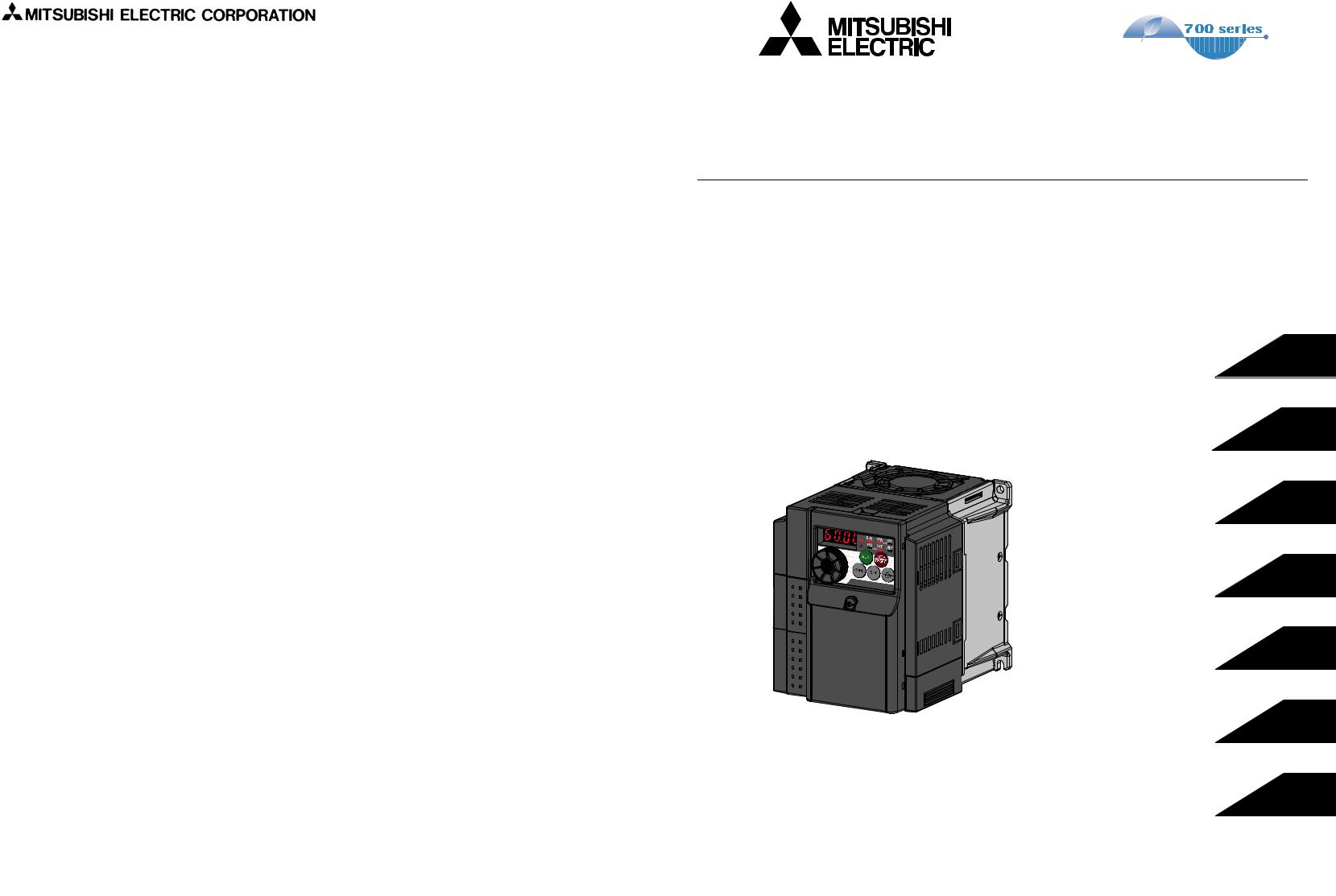
INVERTER
FR-D700
INSTRUCTION MANUAL
FR-D720-008 to 318 - NA
FR-D740-012 to 160 - NA FR-D720S-008 to 100 - NA
OUTLINE
WIRING
PRECAUTIONS FOR USE
OF THE INVERTER
PARAMETERS
TROUBLESHOOTING
PRECAUTIONS FOR
MAINTENANCE AND INSPECTION
SPECIFICATIONS
1
2
3
4
5
6
7
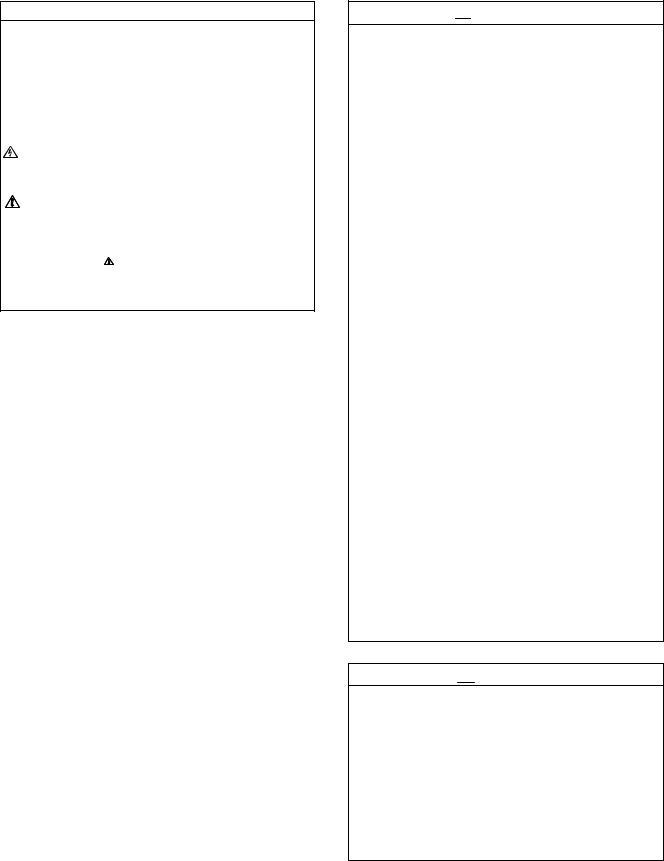
Thank you for choosing this Mitsubishi Inverter.
This Instruction Manual provides instructions for advanced use of the FR-D700 series inverters.
Incorrect handling might cause an unexpected fault. Before using the inverter, always read this instruction manual and the Installation Guideline [IB-0600367ENG] packed with the product carefully to use the equipment to its optimum performance.
1. Electric Shock Prevention
This section is specifically about safety matters
Do not attempt to install, operate, maintain or inspect the inverter until you have read through the Instruction Manual and appended documents carefully and can use the equipment correctly. Do not use this product until you have a full knowledge of the equipment, safety information and instructions.
In this Instruction Manual, the safety instruction levels are classified into "WARNING" and "CAUTION".
|
|
|
|
|
Assumes that incorrect handling may |
||
|
WARNING |
||||||
|
cause hazardous conditions, resulting |
||||||
|
|
|
|
|
in death or severe injury. |
||
|
|
|
|
|
Assumes that incorrect handling may |
||
|
|
CAUTION |
|||||
|
|
cause hazardous conditions, resulting |
|||||
|
|
||||||
|
|
|
|
|
in medium or slight injury, or may |
||
|
|
|
|
|
cause physical damage only. |
||
|
|
|
|
|
|
level may lead to a serious |
|
|
Note that even the |
|
|
|
CAUTION |
||
|
|
|
|
||||
consequence according to conditions. Please follow the instructions of both levels because they are important to personnel safety.
 WARNING
WARNING
While power is on or when the inverter is running, do not open the front cover. Otherwise you may get an electric shock.
Do not run the inverter with the front cover or wiring cover removed. Otherwise, you may access the exposed highvoltage terminals or the charging part of the circuitry and get an electric shock.
Even if power is off, do not remove the front cover except for wiring or periodic inspection. You may access the charged inverter circuits and get an electric shock.
Before starting wiring or inspection, switch off power, check to make sure that the operation panel indicator is off, wait for at least 10 minutes after the power supply has been switched off, and check that there are no residual voltage using a tester or the like. The capacitor is charged with high voltage for some time after power off and it is dangerous.
This inverter must be earthed (grounded). Earthing (grounding) must conform to the requirements of national and local safety regulations and electrical code. (NEC section 250, IEC 536 class 1 and other applicable standards)
Use an neutral-point earthed (grounded) power supply for 400V class inverter in compliance with EN standard.
Any person who is involved in the wiring or inspection of this equipment should be fully competent to do the work. Always install the inverter before wiring. Otherwise, you may get an electric shock or be injured.
Perform setting dial and key operations with dry hands to prevent an electric shock. Otherwise you may get an electric shock.
Do not subject the cables to scratches, excessive stress, heavy loads or pinching. Otherwise, you may get an electric shock.
Do not change the cooling fan while power is on. It is dangerous to change the cooling fan while power is on. Do not touch the printed circuit board with wet hands. Otherwise, you may get an electric shock.
When measuring the main circuit capacitor capacity, the DC voltage is applied to the motor for 1s at powering off. Never touch the motor terminal, etc. right after powering off to prevent an electric shock.
2. Fire Prevention
 CAUTION
CAUTION
Install the inverter on a nonflammable wall without holes (so that nobody can touch the inverter heatsink on the rear side, etc.). Mounting it to or near flammable material can cause a fire.
If the inverter has become faulty, switch off the inverter power. A continuous flow of large current could cause a fire.
When using a brake resistor, make up a sequence that will turn off power when an alarm signal is output. Otherwise, the brake resistor may excessively overheat due to damage of the brake transistor and such, causing a fire.
Do not connect a resistor directly to the DC terminals P/+ and N/-. This could cause a fire.
A-1
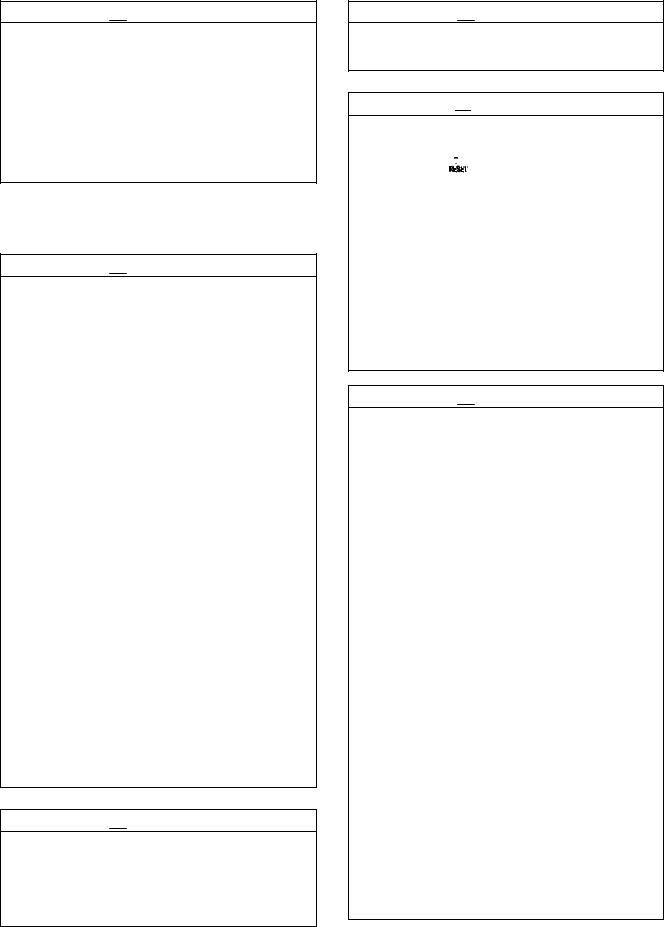
3.Injury Prevention
 CAUTION
CAUTION
Apply only the voltage specified in the instruction manual to each terminal. Otherwise, burst, damage, etc. may occur.
Ensure that the cables are connected to the correct terminals. Otherwise, burst, damage, etc. may occur. Always make sure that polarity is correct to prevent damage, etc. Otherwise, burst, damage, etc. may occur. While power is on or for some time after power-off, do not touch the inverter as they will be extremely hot. Doing so can cause burns.
4. Additional Instructions
Also note the following points to prevent an accidental failure, injury, electric shock, etc.
(1) Transportation and mounting
 CAUTION
CAUTION
Transport the product using the correct method that corresponds to the weight. Failure to observe this could lead to injuries.
Do not stack the inverter boxes higher than the number recommended.
Ensure that installation position and material can withstand the weight of the inverter. Install according to the information in the instruction manual.
Do not install or operate the inverter if it is damaged or has parts missing.
When carrying the inverter, do not hold it by the front cover or setting dial; it may fall off or fail.
Do not stand or rest heavy objects on the product. Check the inverter mounting orientation is correct.
Prevent other conductive bodies such as screws and metal fragments or other flammable substance such as oil from entering the inverter.
As the inverter is a precision instrument, do not drop or subject it to impact.
Use the inverter under the following environmental conditions: Otherwise, the inverter may be damaged.
|
Surrounding |
-10°C to +50°C (14°F to 122°F) (non-freezing) |
|
|
air |
||
|
temperature |
|
|
|
Ambient |
90%RH maximum (non-condensing) |
|
Environment |
humidity |
||
|
|||
Storage |
-20°C to +65°C (-4°F to 149°F) *1 |
||
temperature |
|||
Atmosphere |
Indoors (free from corrosive gas, flammable gas, |
||
oil mist, dust and dirt) |
|||
|
Maximum 1000m (3280.80feet) above sea level for |
||
|
|
||
|
Altitude/ |
standard operation. After that derate by 3% for |
|
|
every extra 500m (1640.40feet) up to 2500m |
||
|
vibration |
||
|
(8202feet) (91%). |
||
|
|
5.9m/s2 or less |
1 Temperature applicable for a short time, e.g. in transit.
(2) Wiring
 CAUTION
CAUTION
Do not install a power factor correction capacitor or surge suppressor/capacitor type filter on the inverter output side. These devices on the inverter output side may be overheated or burn out.
The connection orientation of the output cables U, V, W to the motor will affect the direction of rotation of the motor.
(3) Trial run
 CAUTION
CAUTION
Before starting operation, confirm and adjust the parameters. A failure to do so may cause some machines to make unexpected motions.
(4) Usage
 WARNING
WARNING
When you have chosen the retry function, stay away from the equipment as it will restart suddenly after trip.
Since pressing  key may not stop output depending
key may not stop output depending
on the function setting status, provide a circuit and switch separately to make an emergency stop (power off, mechanical brake operation for emergency stop, etc).
Make sure that the start signal is off before resetting the inverter alarm. A failure to do so may restart the motor suddenly.
The load used should be a three-phase induction motor only. Connection of any other electrical equipment to the inverter output may damage the equipment.
Do not modify the equipment.
Do not perform parts removal which is not instructed in this manual. Doing so may lead to fault or damage of the product.
 CAUTION
CAUTION
The electronic thermal relay function does not guarantee protection of the motor from overheating. It is recommended to install both an external thermal and PTC thermistor for overheat protection.
Do not use a magnetic contactor on the inverter input for frequent starting/stopping of the inverter. Otherwise, the life of the inverter decreases.
Use a noise filter to reduce the effect of electromagnetic interference. Otherwise nearby electronic equipment may be affected.
Take measures to suppress harmonics. Otherwise power supply harmonics from the inverter may heat/damage the power factor correction capacitor and generator.
When a 400V class motor is inverter-driven, please use an insulation-enhanced motor or measures taken to suppress surge voltages. Surge voltages attributable to the wiring constants may occur at the motor terminals, deteriorating the insulation of the motor.
When parameter clear or all parameter clear is performed, reset the required parameters before starting operations. Each parameter returns to the initial value.
The inverter can be easily set for high-speed operation. Before changing its setting, fully examine the performances of the motor and machine.
In addition to the inverter’s holding function, install a holding device to ensure safety.
Before running an inverter which had been stored for a long period, always perform inspection and test operation.
For prevention of damage due to static electricity, touch nearby metal before touching this product to eliminate static electricity from your body.
A-2
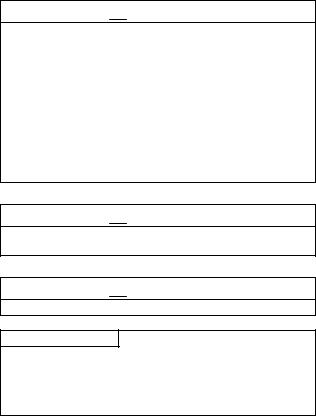
(5) Emergency stop
 CAUTION
CAUTION
Provide a safety backup such as an emergency brake which will prevent the machine and equipment from hazardous conditions if the inverter fails.
When the breaker on the inverter input side trips, check for the wiring fault (short circuit), damage to internal parts of the inverter, etc. Identify the cause of the trip, then remove the cause and power on the breaker.
When any protective function is activated, take the appropriate corrective action, then reset the inverter, and resume operation.
(6) Maintenance, inspection and parts replacement
 CAUTION
CAUTION
Do not carry out a megger (insulation resistance) test on the control circuit of the inverter. It will cause a failure.
(7) Disposal
 CAUTION
CAUTION
Treat as industrial waste.
General instruction
Many of the diagrams and drawings in this Instruction Manual show the inverter without a cover, or partially open. Never operate the inverter in this manner. Always replace the cover and follow this Instruction Manual when operating the inverter.
A-3

CONTENTS
1 |
OUTLINE |
1 |
||
|
1.1 |
Product checking and parts identification......................................... |
2 |
|
|
1.2 |
Inverter and peripheral devices.......................................................... |
3 |
|
|
1.2.1 |
Peripheral devices .......................................................................................................................... |
4 |
|
|
1.3 |
Removal and reinstallation of the cover ............................................ |
5 |
|
|
1.3.1 |
Front cover...................................................................................................................................... |
5 |
|
|
1.3.2 |
Wiring cover.................................................................................................................................... |
7 |
|
|
1.4 |
Installation of the inverter and enclosure design.............................. |
8 |
|
|
1.4.1 |
Inverter installation environment..................................................................................................... |
8 |
|
|
1.4.2 Cooling system types for inverter enclosure................................................................................. |
10 |
||
|
1.4.3 |
Inverter placement ........................................................................................................................ |
11 |
|
2 |
WIRING |
13 |
||
|
2.1 |
Wiring................................................................................................. |
14 |
|
|
2.1.1 |
Terminal connection diagram ....................................................................................................... |
14 |
|
|
2.2 |
Main circuit terminal specifications................................................. |
15 |
|
|
2.2.1 Specification of main circuit terminal ............................................................................................ |
15 |
||
|
2.2.2 Terminal arrangement of the main circuit terminal, power supply and the motor wiring............... |
15 |
||
|
2.2.3 Cables and wiring length .............................................................................................................. |
17 |
||
|
2.3 |
Control circuit specifications ........................................................... |
20 |
|
|
2.3.1 |
Control circuit terminal .................................................................................................................. |
20 |
|
|
2.3.2 Changing the control logic ............................................................................................................ |
22 |
||
|
2.3.3 Wiring of control circuit ................................................................................................................. |
24 |
||
|
2.3.4 |
Wiring instructions ........................................................................................................................ |
28 |
|
|
2.3.5 Connection to the PU connector................................................................................................... |
29 |
||
|
2.4 |
Connection of stand-alone option unit ............................................. |
31 |
|
2.4.1Connection of a dedicated external brake resistor (MRS type, MYS type, FR-ABR)
(FR-D720-025 or more, FR-D740-012 or more, FR-D720S-025 or more) |
................................... 31 |
2.4.2 Connection of the brake unit (FR-BU2) ........................................................................................ |
33 |
2.4.3 Connection of the high power factor converter (FR-HC) .............................................................. |
34 |
2.4.4 Connection of the power regeneration common converter (FR-CV) ............................................ |
35 |
2.4.5 Connection of a DC reactor (FR-HEL).......................................................................................... |
35 |
3 PRECAUTIONS FOR USE OF THE INVERTER |
37 |
3.1 EMC and leakage currents................................................................ |
38 |
I

3.1.1 |
Leakage currents and countermeasures ...................................................................................... |
38 |
3.1.2 |
EMC measures............................................................................................................................. |
40 |
3.1.3 Power supply harmonics .............................................................................................................. |
42 |
|
3.2 |
Installation of power factor improving reactor ............................... |
43 |
3.3 |
Power-off and magnetic contactor (MC).......................................... |
44 |
3.4 |
Inverter-driven 400V class motor .................................................... |
45 |
3.5 |
Precautions for use of the inverter .................................................. |
46 |
3.6 |
Failsafe of the system which uses the inverter .............................. |
48 |
CONTENTS
4 PARAMETERS |
51 |
||
|
|
|
|
4.1 |
Operation panel ................................................................................ |
52 |
|
4.1.1 Names and functions of the operation panel ................................................................................ |
52 |
||
4.1.2 Basic operation (factory setting) ................................................................................................... |
53 |
||
4.1.3 Easy operation mode setting (easy setting mode) ....................................................................... |
54 |
||
4.1.4 Change the parameter setting value ............................................................................................ |
55 |
||
4.1.5 |
Setting dial push ........................................................................................................................... |
55 |
|
4.2 |
Parameter list ................................................................................... |
56 |
|
4.2.1 |
Parameter list ............................................................................................................................... |
56 |
|
4.3 |
Adjust the output torque (current) of the motor............................. |
73 |
|
4.3.1 Manual torque boost (Pr. 0, Pr. 46) ............................................................................................. |
73 |
||
4.3.2Large starting torque and low speed torque are necessary (General-purpose magnetic flux vector
|
control (Pr. 71, Pr. 80)) ................................................................................................................ |
75 |
4.3.3 Slip compensation (Pr. 245 to Pr. 247)........................................................................................ |
78 |
|
4.3.4 Stall prevention operation (Pr. 22, Pr. 23, Pr. 48, Pr. 66, Pr. 156, Pr. 157)................................. |
79 |
|
4.4 |
Limit the output frequency.............................................................. |
83 |
4.4.1 Maximum/minimum frequency (Pr. 1, Pr. 2, Pr. 18) .................................................................... |
83 |
|
4.4.2 Avoid mechanical resonance points (frequency jumps) (Pr. 31 to Pr. 36)................................... |
84 |
|
4.5 |
Set V/F pattern................................................................................. |
85 |
4.5.1 Base frequency, voltage (Pr. 3, Pr. 19, Pr. 47)............................................................................ |
85 |
|
4.5.2 Load pattern selection (Pr. 14) .................................................................................................... |
87 |
|
4.6 |
Frequency setting by external terminals........................................ |
89 |
4.6.1 Operation by multi-speed operation (Pr. 4 to Pr. 6, Pr. 24 to Pr. 27, Pr. 232 to Pr. 239) ............ |
89 |
|
4.6.2 Jog operation (Pr. 15, Pr. 16) ...................................................................................................... |
91 |
|
4.6.3 Remote setting function (Pr. 59).................................................................................................. |
93 |
|
4.7Setting of acceleration/deceleration time and acceleration/
deceleration pattern........................................................................ |
96 |
II
4.7.1Setting of the acceleration and deceleration time
|
(Pr. 7, Pr. 8, Pr. 20, Pr. 44, Pr. 45) ............................................................................................. |
96 |
4.7.2 |
Starting frequency and start-time hold function (Pr. 13, Pr. 571)................................................. |
98 |
4.7.3 |
Acceleration/deceleration pattern (Pr. 29) ................................................................................... |
99 |
4.8 Selection and protection of a motor.............................................. |
100 |
|
4.8.1Motor overheat protection (Electronic thermal O/L relay, PTC thermistor protection) (Pr. 9, Pr. 51,
Pr. 561) ...................................................................................................................................... |
100 |
4.8.2 Applied motor (Pr. 71, Pr. 450) .................................................................................................. |
103 |
4.8.3To exhibit the best performance of the motor (offline auto tuning)
|
(Pr. 71, Pr. 80, Pr. 82 to Pr. 84, Pr. 90, Pr. 96).......................................................................... |
105 |
4.9 Motor brake and stop operation .................................................... |
109 |
|
4.9.1 |
DC injection brake (Pr. 10 to Pr. 12).......................................................................................... |
109 |
4.9.2 |
Selection of a regenerative brake (Pr. 30, Pr. 70) ..................................................................... |
110 |
4.9.3 |
Stop selection (Pr. 250) ............................................................................................................. |
112 |
4.10 Function assignment of external terminal and control ................ |
113 |
|
4.10.1 |
Input terminal function selection (Pr. 178 to Pr. 182)................................................................. |
113 |
4.10.2 |
Inverter output shutoff signal (MRS signal, Pr. 17) .................................................................... |
115 |
4.10.3 |
Condition selection of function validity by second function selection signal (RT) ...................... |
116 |
4.10.4 |
Start signal operation selection (STF, STR, STOP signal, Pr. 250) .......................................... |
117 |
4.10.5 |
Output terminal function selection (Pr. 190, Pr. 192)................................................................. |
119 |
4.10.6 |
Detection of output frequency (SU, FU signal, Pr. 41 to Pr. 43) ................................................ |
123 |
4.10.7 |
Output current detection function |
|
|
(Y12 signal, Y13 signal, Pr. 150 to Pr. 153, Pr. 166, Pr. 167) ................................................... |
124 |
4.10.8 |
Remote output selection (REM signal, Pr. 495, Pr. 496) ........................................................... |
126 |
4.11 Monitor display and monitor output signal.................................... |
127 |
|
4.11.1 |
Speed display and speed setting (Pr. 37).................................................................................. |
127 |
4.11.2 |
Monitor display selection of operation panel/PU and terminal AM |
|
|
(Pr. 52, Pr.158, Pr. 170, Pr. 171, Pr. 268, Pr. 563, Pr. 564, Pr. 891)......................................... |
128 |
4.11.3 |
Reference of the terminal AM (analog voltage output) (Pr. 55, Pr. 56)...................................... |
133 |
4.11.4 |
Terminal AM calibration (calibration parameter C1 (Pr.901)) .................................................... |
134 |
4.12 Operation selection at power failure and instantaneous power |
|
|
failure ............................................................................................. |
136 |
|
4.12.1 |
Automatic restart after instantaneous power failure/flying start |
|
|
(Pr. 30, Pr. 57, Pr. 58, Pr. 96, Pr. 162, Pr. 165, Pr. 298, Pr. 299, Pr. 611) ................................ |
136 |
4.12.2 |
Power-failure deceleration stop function (Pr. 261)..................................................................... |
142 |
4.13 Operation setting at fault occurrence........................................... |
144 |
|
4.13.1 |
Retry function (Pr. 65, Pr. 67 to Pr. 69) ..................................................................................... |
144 |
4.13.2 |
Input/output phase loss protection selection (Pr. 251, Pr. 872) ................................................. |
146 |
4.13.3 |
Earth (ground) fault detection at start (Pr. 249) ......................................................................... |
146 |
4.14 Energy saving operation ................................................................ |
147 |
|
III

4.14.1 Optimum excitation control (Pr. 60) ........................................................................................... |
147 |
4.15 Motor noise, EMI measures, mechanical resonance.................... |
148 |
4.15.1 PWM carrier frequency and Soft-PWM control (Pr. 72, Pr. 240, Pr. 260) ................................. |
148 |
4.15.2 Speed smoothing control (Pr. 653)............................................................................................ |
149 |
4.16 Frequency setting by analog input (terminal 2, 4) ....................... |
150 |
4.16.1 Analog input selection (Pr. 73, Pr. 267)..................................................................................... |
150 |
4.16.2 Response level of analog input and noise elimination (Pr. 74).................................................. |
152 |
4.16.3 Bias and gain of frequency setting voltage (current) |
|
(Pr. 125, Pr. 126, Pr. 241, C2 (Pr. 902) to C7 (Pr. 905)) ........................................................... |
153 |
CONTENTS
4.17 Misoperation prevention and parameter setting restriction........ |
158 |
4.17.1 Reset selection/disconnected PU detection/PU stop selection (Pr. 75) .................................... |
158 |
4.17.2 Parameter write disable selection (Pr. 77)................................................................................. |
161 |
4.17.3 Reverse rotation prevention selection (Pr. 78) .......................................................................... |
162 |
4.17.4 Extended parameter display (Pr. 160)....................................................................................... |
162 |
4.17.5 Password function (Pr. 296, Pr. 297)......................................................................................... |
163 |
4.18 Selection of operation mode and operation location ................... |
165 |
4.18.1 Operation mode selection (Pr. 79)............................................................................................. |
165 |
4.18.2 Operation mode at power-on (Pr. 79, Pr. 340) .......................................................................... |
175 |
4.18.3 Start command source and frequency command source during communication |
|
operation (Pr. 338, Pr. 339, Pr. 551) ......................................................................................... |
176 |
4.19 Communication operation and setting ......................................... |
180 |
4.19.1 Wiring and configuration of PU connector ................................................................................. |
180 |
4.19.2 Initial settings and specifications of RS-485 communication |
|
(Pr. 117 to Pr. 120, Pr. 123, Pr. 124, Pr. 549) ........................................................................... |
183 |
4.19.3 Operation selection at communication error occurrence (Pr. 121, Pr. 122, Pr. 502)................. |
184 |
4.19.4 Communication EEPROM write selection (Pr. 342) .................................................................. |
187 |
4.19.5 Mitsubishi inverter protocol (computer link communication)...................................................... |
188 |
4.19.6 Modbus RTU communication specifications |
|
(Pr. 117, Pr. 118, Pr. 120, Pr. 122, Pr. 343, Pr. 502, Pr. 549) ................................................... |
200 |
4.20 Special operation and frequency control ..................................... |
212 |
4.20.1 PID control (Pr. 127 to Pr. 134, Pr. 575 to Pr. 577) ................................................................... |
212 |
4.20.2 Dancer control (Pr. 44, Pr. 45, Pr. 128 to Pr. 134) .................................................................... |
220 |
4.20.3 Regeneration avoidance function (Pr. 665, Pr. 882, Pr. 883, Pr. 885, Pr. 886)......................... |
226 |
4.21 Useful functions ............................................................................ |
228 |
4.21.1 Cooling fan operation selection (Pr. 244) .................................................................................. |
228 |
4.21.2 Display of the life of the inverter parts (Pr. 255 to Pr. 259)........................................................ |
229 |
4.21.3 Maintenance timer alarm (Pr. 503, Pr. 504) .............................................................................. |
233 |
4.21.4 Current average value monitor signal (Pr. 555 to Pr. 557) ........................................................ |
234 |
4.21.5 Free parameter (Pr. 888, Pr. 889) ............................................................................................. |
236 |
IV

|
4.22 Setting the parameter unit and operation panel........................... |
237 |
|
|
4.22.1 |
RUN key rotation direction selection (Pr. 40)............................................................................ |
. 237 |
|
4.22.2 |
PU display language selection(Pr.145).................................................................................... |
.. 237 |
|
4.22.3 |
Operation panel frequency setting/key lock operation selection (Pr. 161)................................. |
238 |
|
4.22.4 |
Magnitude of frequency change setting (Pr. 295)...................................................................... |
240 |
|
4.22.5 |
Buzzer control (Pr. 990)............................................................................................................. |
241 |
|
4.22.6 |
PU contrast adjustment (Pr. 991) .............................................................................................. |
241 |
|
4.23 Parameter clear/ All parameter clear............................................ |
242 |
|
|
4.24 Initial value change list ................................................................. |
243 |
|
|
4.25 Check and clear of the faults history ............................................ |
244 |
|
5 |
TROUBLESHOOTING |
247 |
|
|
|
|
|
|
5.1 Reset method of protective function.............................................. |
248 |
|
|
5.2 List of fault or alarm indications .................................................... |
249 |
|
|
5.3 Causes and corrective actions....................................................... |
250 |
|
|
5.4 Correspondences between digital and actual characters............. |
259 |
|
|
5.5 Check first when you have some troubles ..................................... |
260 |
|
|
5.5.1 |
Motor will not start....................................................................................................................... |
260 |
|
5.5.2 |
Motor generates abnormal noise ................................................................................................ |
260 |
|
5.5.3 |
Motor generates heat abnormally ............................................................................................... |
261 |
|
5.5.4 |
Motor rotates in opposite direction.............................................................................................. |
261 |
|
5.5.5 |
Speed greatly differs from the setting ......................................................................................... |
261 |
|
5.5.6 |
Acceleration/deceleration is not smooth ..................................................................................... |
261 |
|
5.5.7 |
Motor current is large.................................................................................................................. |
261 |
|
5.5.8 |
Speed does not increase ............................................................................................................ |
261 |
|
5.5.9 |
Speed varies during operation.................................................................................................... |
262 |
|
5.5.10 |
Operation mode is not changed properly.................................................................................... |
262 |
|
5.5.11 |
Operation panel display is not operating .................................................................................... |
262 |
|
5.5.12 |
Parameter write cannot be performed ........................................................................................ |
262 |
6 |
PRECAUTIONS FOR MAINTENANCE AND INSPECTION |
263 |
|
|
6.1 Inspection items ............................................................................. |
264 |
|
|
6.1.1 |
Daily inspection........................................................................................................................... |
264 |
|
6.1.2 |
Periodic inspection...................................................................................................................... |
264 |
|
6.1.3 |
Daily and periodic inspection ...................................................................................................... |
265 |
|
6.1.4 |
Display of the life of the inverter parts ........................................................................................ |
266 |
|
6.1.5 |
Checking the inverter and converter modules ............................................................................ |
266 |
V
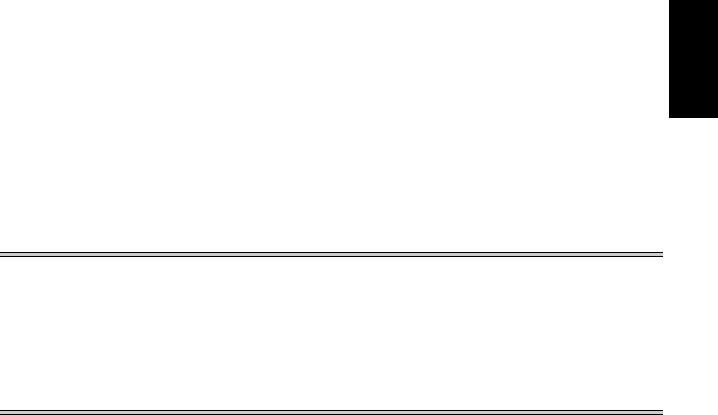
6.1.6 |
Cleaning ..................................................................................................................................... |
266 |
6.1.7 |
Replacement of parts ................................................................................................................. |
267 |
6.2 Measurement of main circuit voltages, currents and powers ...... |
271 |
|
6.2.1 |
Measurement of powers ............................................................................................................. |
273 |
6.2.2 Measurement of voltages and use of PT.................................................................................... |
273 |
|
6.2.3 |
Measurement of currents............................................................................................................ |
274 |
6.2.4 Use of CT and transducer .......................................................................................................... |
274 |
|
6.2.5 Measurement of inverter input power factor ............................................................................... |
274 |
|
6.2.6 Measurement of converter output voltage (across terminals P and N) ...................................... |
274 |
|
6.2.7 Insulation resistance test using megger ..................................................................................... |
275 |
|
6.2.8 |
Pressure test .............................................................................................................................. |
275 |
CONTENTS
7 SPECIFICATIONS |
277 |
|
7.1 |
Rating.............................................................................................. |
278 |
7.2 |
Common specifications.................................................................. |
280 |
7.3 |
Outline dimension drawings........................................................... |
281 |
APPENDIX |
285 |
|
Appendix1 Index........................................................................................................... |
286 |
|
VI
MEMO
VII
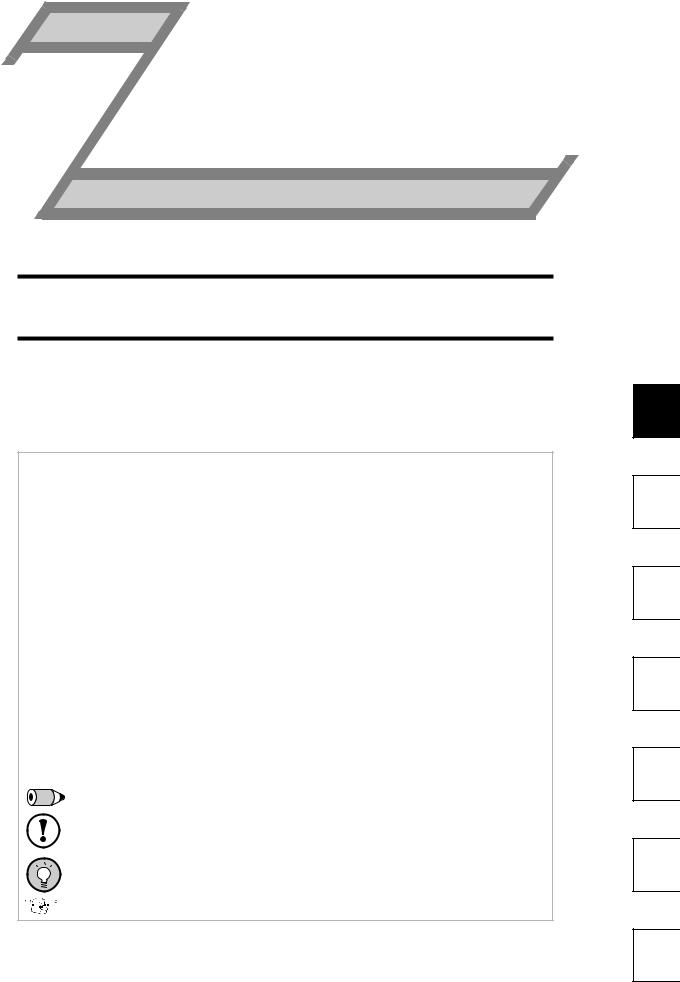
1 OUTLINE
This chapter explains the "OUTLINE" for use of this product. Always read the instructions before using the equipment
1.1 Product checking and parts identification ................................. |
2 |
|
1.2 Inverter and peripheral devices................................................... |
3 |
|
1.3 Removal and reinstallation of the cover..................................... |
5 |
|
1.4 Installation of the inverter and enclosure design ...................... |
8 |
|
<Abbreviations> |
|
|
PU .................................................. |
Operation panel and parameter unit (FR-PU04/FR-PU07) |
|
Inverter ........................................... |
Mitsubishi inverter FR-D700 series |
|
FR-D700 ........................................ |
Mitsubishi inverter FR-D700 series |
|
Pr.................................................... |
Parameter number |
|
PU operation .................................. |
Operation using the PU (operation panel/FR-PU04/FR-PU07) |
|
External operation .......................... |
Operation using the control circuit signals |
|
Combined operation ....................... |
Operation using both the PU (operation panel/FR-PU04/FR- |
|
|
PU07) and external operation |
|
Operation panel for E500, PA02..... FR-E500 series operation panel (FR-PA02-02) |
|
|
Mitsubishi standard motor .............. |
SF-JR |
|
Mitsubishi constant-torque motor ... |
SF-HRCA |
|
<Trademarks> |
|
|
Microsoft and Visual C++ are registered trademarks of Microsoft Corporation in the United States |
||
and/or other countries. |
|
|
Company and product names herein are the trademarks and registered trademarks of their |
||
respective owners. |
|
|
<Mark> |
|
|
REMARKS :Additional helpful contents and relations with other functions are stated |
||
NOTE :Contents requiring caution or cases when set functions are not |
||
activated are stated. |
|
|
POINT :Useful contents and points are stated. |
|
|
Parameters referred to : related parameters are stated. |
|
|
1
2
3
4
5
6
7
1

 Product checking and parts identification
Product checking and parts identification
1.1Product checking and parts identification
Unpack the inverter and check the capacity plate on the front cover and the rating plate on the inverter side face to ensure that the product agrees with your order and the inverter is intact.
Inverter type
|
FR - |
D740 |
- |
036 |
- NA |
|||
|
|
|
|
|
|
|
|
|
Symbol |
Voltage class |
|
|
Displays the rated |
||||
D720 |
Three-phase 200V class |
|
|
|||||
|
|
current |
||||||
D740 |
Three-phase 400V class |
|
|
|
|
|
||
|
|
|
|
|
||||
D720S |
Single-phase 200V class |
|
|
|
|
|
||
Operation panel
(Refer to page 52)
Voltage/current input switch
(Refer to page 20)
PU connector
(Refer to page 21)
Front cover
(Refer to page 5)
Capacity plate
Cooling fan
(Refer to page 267)
Control circuit terminal block
(Refer to page 20)
Control logic switchover jumper connector
(Refer to page 22)
Main circuit terminal block
(Refer to page 15)
Combed shaped wiring cover
(Refer to page 7)






 036 NA
036 NA 


Inverter type |
Serial number |
Rating plate |
|
Inverter type |
FR-D740-036-NA |
Input rating |
|
Output rating |
|
Serial number |
|
•Accessory
·Fan cover fixing screws (M3 × 35mm)
These screws are necessary for compliance with the European Directive (Refer to Installation Guideline)
Type |
Number |
|
FR-D720-070 to 165 |
|
|
FR-D740-036 to 080 |
1 |
|
FR-D720S-070, 100 |
|
|
FR-D720-120, 160 |
2 |
|
FR-D740-120, 160 |
||
|
2
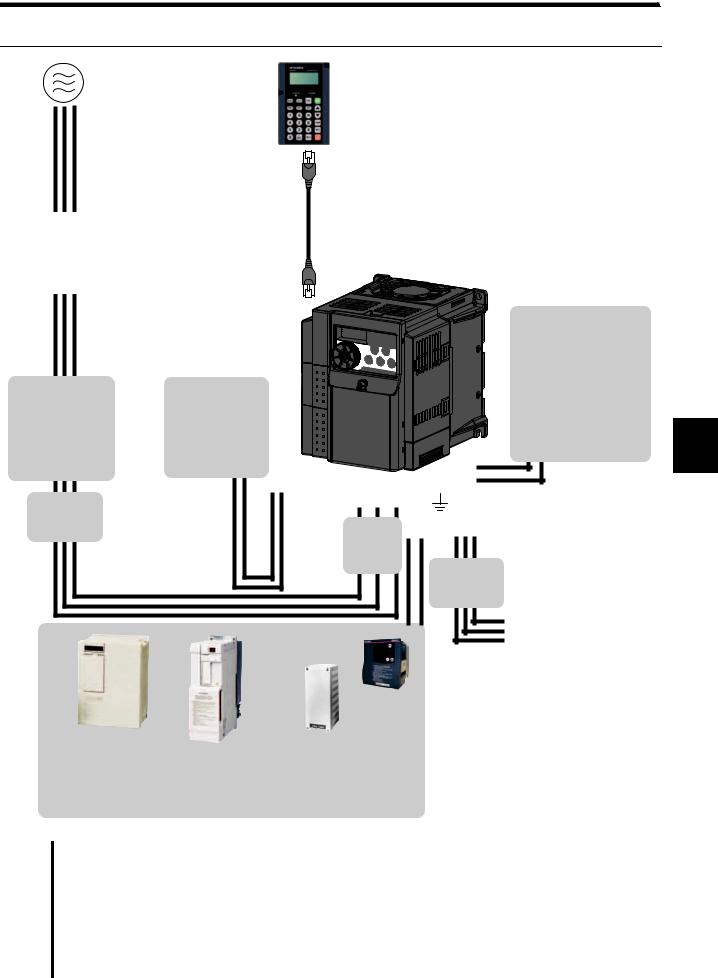
Inverter and peripheral devices 
1.2Inverter and peripheral devices
Three-phase AC power supply |
Parameter unit (FR-PU07) |
|
|
Use within the permissible power supply |
By connecting the connection cable |
|
|
specifications of the inverter. To ensure |
|
||
(FR-CB2) to the PU connector, |
|
||
safety, use a moulded case circuit breaker, |
|
||
operation can be performed from |
|
||
earth leakage circuit breaker or magnetic |
|
||
FR-PU07. |
|
||
contactor to switch power ON/OFF. |
|
||
(Refer to page 29) |
|
||
|
(Refer to page 281) |
|
|
Moulded case circuit breaker |
|
RS-232C - RS-485 converter is |
|
|
required when connecting to PC |
||
(MCCB) or earth leakage circuit |
|
||
|
with RS-232C interface. |
||
|
|
|
|
breaker (ELB), fuse |
|
(Refer to page 180) |
|
The breaker must be selected carefully |
|
||
|
|
||
since an in-rush current flows in the |
|
|
|
inverter at power on. |
RS-485 RS-232C |
|
|
|
(Refer to page 4) |
Converter |
|
Magnetic contactor (MC) |
|
|
|
Install the magnetic contactor to ensure |
|
|
|
safety. Do not use this magnetic contactor |
|
|
|
to start and stop the inverter. Doing so will |
|
|
|
cause the inverter life to be shorten. |
S1 |
Safety relay module |
|
(Refer to page 44) |
S2 |
Required for |
|
Reactor (FR-HAL, FR-HEL option) |
SC |
compliance with |
|
Reactors (option) must be used when |
|
safety standard. |
|
power harmonics measures are taken, |
|
|
|
the power factor is to be improved or the |
|
|
|
inverter is installed near a large power |
|
|
|
supply system (500kVA or more). The |
|
|
|
inverter may be damaged if you do not |
|
|
|
use reactors. Select the reactor according |
|
|
|
to the model. Remove the jumpers across |
|
Brake resistor (FR-ABR, |
|
terminals P/+ and P1 to connect the DC reactor. |
|
||
AC reactor (FR-HAL) |
DC reactor (FR-HEL) |
|
MRS type, MYS type) |
|
Braking capability can be |
||
|
|
|
|
|
|
|
improved. |
|
|
|
(FR-D720-025 or more, |
|
|
|
FR-D740-012 or more, |
|
|
|
FR-D720S-025 or more) |
(Refer to page 31)
P/+ |
Noise filter |
Inverter (FR-D700) |
PR |
|
||
P/+P1 |
|
|
|
||
(FR-BSF01, FR-BLF) |
|
|
Noise filter |
||
|
R/L1 S/L2 T/L3 |
|
|||
Install a noise filter to reduce |
|
|
(FR-BSF01, FR-BLF) |
||
|
|
|
|||
the electromagnetic noise |
Capacitor type |
Earth (Ground) |
Install a noise filter to reduce the |
||
generated from the inverter. |
|
|
electromagnetic noise generated |
||
filter |
P/+ N/- |
U V W |
|||
Effective in the range from |
|||||
from the inverter. |
|||||
(FR-BIF) |
|
|
|||
about 1MHz to 10MHz. When |
|
|
|||
|
|
Effective in the range from about |
|||
|
|
|
|||
more wires are passed |
Reduces the |
|
|
||
|
|
1MHz to 10MHz. A wire should be |
|||
through, a more effective result |
radio noise. |
|
|
||
|
|
wound four turns at a maximum. |
|||
can be obtained. A wire should |
|
|
|
||
|
|
|
|
||
be wound four turns or more. |
|
|
|
|
|
Brake unit (FR-BU2)
|
|
P/+ PR |
|||
|
|
P/+ |
|
|
|
|
|
|
|
||
|
|
PR |
|
|
|
|
|
|
|
|
|
High power factor |
Power regeneration |
Resistor unit (FR-BR) |
|||
converter (FR-HC) |
common converter |
Discharging resistor (GZG, GRZG) |
|||
|
(FR-CV) |
|
|
|
|
Power supply harmonics |
Great braking capability |
The regenerative braking capability |
|||
can be greatly suppressed. |
is obtained. |
of the inverter can be exhibited fully. |
|||
Install this as required. |
Install this as required. |
Install this as required. |
|||
Earth (Ground)
Devices connected to the output
Do not install a power factor correction capacitor, surge suppressor or capacitor type filter on the output side of the inverter. When installing a moulded case circuit breaker on the output side of the inverter, contact each manufacturer for selection of the moulded case circuit breaker.
Earth (Ground)
To prevent an electric shock, always earth (ground) the motor and inverter. For reduction of induction noise from the power line of the inverter, it is recommended to wire the earth (ground) cable by returning it to the earth (ground) terminal of the inverter.
NOTE
The life of the inverter is influenced by surrounding air temperature. The surrounding air temperature should be as low as possible within the permissible range. This must be noted especially when the inverter is installed in an enclosure. (Refer to page 8) Wrong wiring might lead to damage of the inverter. The control signal lines must be kept fully away from the main circuit to protect them from noise. (Refer to page 14)
Do not install a power factor correction capacitor, surge suppressor or capacitor type filter on the inverter output side. This will cause the inverter to trip or the capacitor and surge suppressor to be damaged. If any of the above devices are connected, immediately remove them.
Electromagnetic wave interference
The input/output (main circuit) of the inverter includes high frequency components, which may interfere with the communication devices (such as AM radios) used near the inverter. In this case, install the FR-BIF optional capacitor type filter (for use in the input side only) or FR-BSF01 or FR-BLF common mode filter to minimize interference. (Refer to page 40). Refer to the instruction manual of each option and peripheral devices for details of peripheral devices.
1 OUTLINE
3
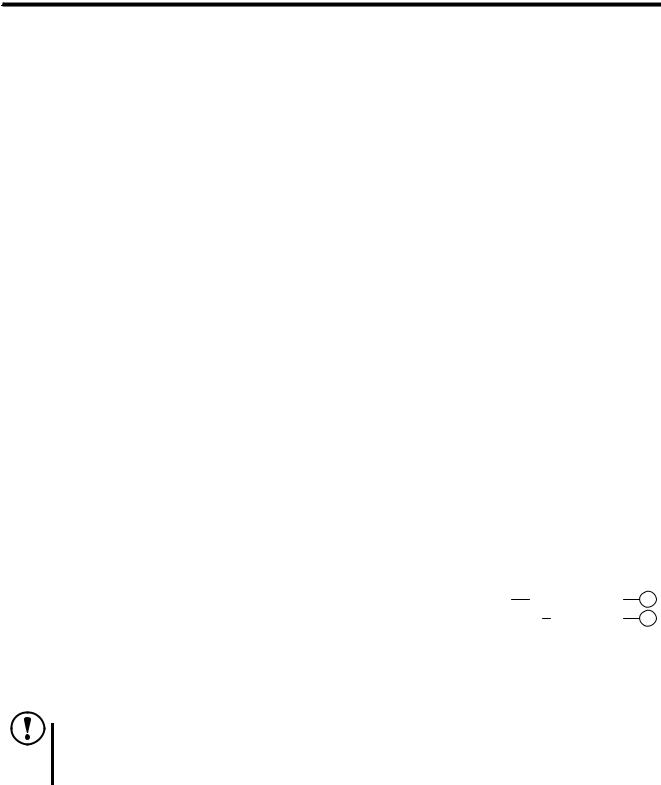
 Inverter and peripheral devices
Inverter and peripheral devices
1.2.1Peripheral devices
Check the inverter type of the inverter you purchased. Appropriate peripheral devices must be selected according to the capacity.
Refer to the following list and prepare appropriate peripheral devices:
|
|
Motor |
Moulded Case Circuit Breaker (MCCB) 1 |
Magnetic Contactor (MC) 3 |
|||
|
|
or Earth Leakage Circuit Breaker (ELB) 2 |
|||||
|
Inverter Type |
Output |
|
|
|||
|
Reactor connection |
Reactor connection |
|||||
|
|
(kW (HP)) |
|||||
|
|
without |
with |
without |
with |
||
|
|
|
|||||
|
FR-D720-008 |
0.1 (1/8) |
30AF 5A |
30AF 5A |
S-N10 |
S-N10 |
|
200V |
FR-D720-014 |
0.2 (1/4) |
30AF 5A |
30AF 5A |
S-N10 |
S-N10 |
|
FR-D720-025 |
0.4 (1/2) |
30AF 5A |
30AF 5A |
S-N10 |
S-N10 |
||
|
|||||||
Phase- |
FR-D720-042 |
0.75 (1) |
30AF 10A |
30AF 5A |
S-N10 |
S-N10 |
|
FR-D720-070 |
1.5 (2) |
30AF 15A |
30AF 10A |
S-N10 |
S-N10 |
||
|
|||||||
Three |
FR-D720-100 |
2.2 (3) |
30AF 20A |
30AF 15A |
S-N10 |
S-N10 |
|
FR-D720-165 |
3.7 (5) |
30AF 30A |
30AF 30A |
S-N20, S-N21 |
S-N10 |
||
|
|||||||
|
FR-D720-238 |
5.5 (7.5) |
50AF 50A |
50AF 40A |
S-N20, S-N21 |
S-N20, S-N21 |
|
|
FR-D720-318 |
7.5 (10) |
100AF 60A |
50AF 50A |
S-N25 |
S-N20, S-N21 |
|
400V |
FR-D740-012 |
0.4 (1/2) |
30AF 5A |
30AF 5A |
S-N10 |
S-N10 |
|
FR-D740-022 |
0.75 (1) |
30AF 5A |
30AF 5A |
S-N10 |
S-N10 |
||
|
|||||||
Phase |
FR-D740-036 |
1.5 (2) |
30AF 10A |
30AF 10A |
S-N10 |
S-N10 |
|
FR-D740-050 |
2.2 (3) |
30AF 15A |
30AF 10A |
S-N10 |
S-N10 |
||
|
|||||||
Three- |
FR-D740-080 |
3.7 (5) |
30AF 20A |
30AF 15A |
S-N10 |
S-N10 |
|
FR-D740-120 |
5.5 (7.5) |
30AF 30A |
30AF 20A |
S-N20 |
S-N11, S-N12 |
||
|
|||||||
|
FR-D740-160 |
7.5 (10) |
30AF 30A |
30AF 30A |
S-N20 |
S-N20 |
|
200V |
FR-D720S-008 |
0.1 (1/8) |
30AF 5A |
30AF 5A |
S-N10 |
S-N10 |
|
FR-D720S-014 |
0.2 (1/4) |
30AF 5A |
30AF 5A |
S-N10 |
S-N10 |
||
Phase- |
|
|
|
|
|
|
|
FR-D720S-042 |
0.75 (1) |
30AF 15A |
30AF 10A |
S-N10 |
S-N10 |
||
|
FR-D720S-025 |
0.4 (1/2) |
30AF 10A |
30AF 5A |
S-N10 |
S-N10 |
|
Single |
|
|
|
|
|
|
|
FR-D720S-070 |
1.5 (2) |
30AF 30A |
30AF 15A |
S-N10 |
S-N10 |
||
|
|||||||
|
FR-D720S-100 |
2.2 (3) |
30AF 40A |
30AF 30A |
S-N20, S-N21 |
S-N10 |
|
1 Select an MCCB according to the power supply capacity. |
|
|
|
|
|
|
Install one MCCB per inverter. |
|
|
MCCB |
|
INV |
IM |
|
|
|
|
|
|
|
|
|
|
MCCB |
|
INV |
IM |
|
|
|
|
2 For installations in the United States or Canada, use the class T type fuse certified by the UL and cUL.
3 Magnetic contactor is selected based on the AC-1 class. The electrical durability of magnetic contactor is 500,000 times. When the magnetic contactor is used for emergency stop during motor driving, the electrical durability is 25 times.
When using the MC for emergency stop during motor driving or using on the motor side during commercial-power supply operation, select the MC with class AC-3 rated current for the motor rated current.
NOTE
When the inverter capacity is larger than the motor capacity, select an MCCB and a magnetic contactor according to the inverter type and cable and reactor according to the motor output.
When the breaker on the inverter primary side trips, check for the wiring fault (short circuit), damage to internal parts of the inverter, etc. Identify the cause of the trip, then remove the cause and power on the breaker.
4
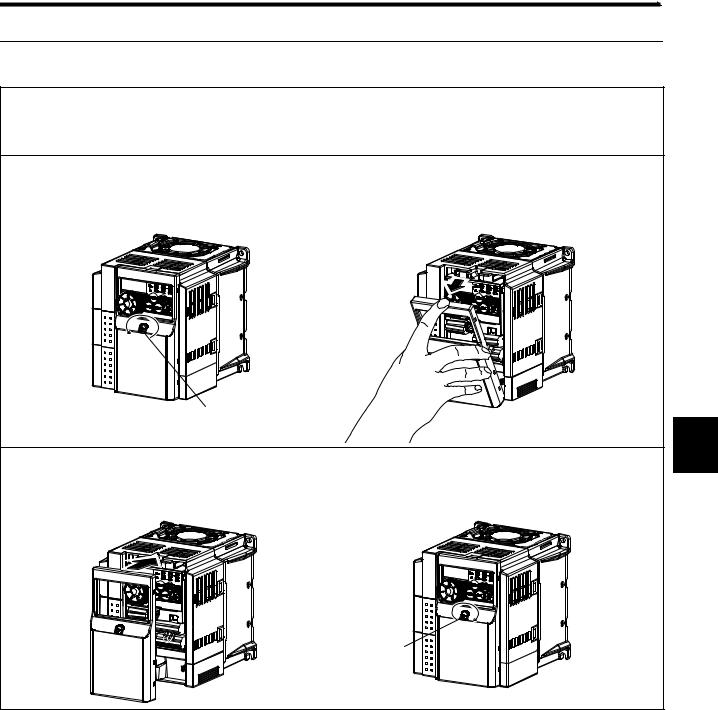
Removal and reinstallation of the cover 
1.3Removal and reinstallation of the cover
1.3.1Front cover
FR-D720-165 or less
FR-D740-080 or less
FR-D720S-008 to 100
Removal (Example of FR-D740-036)
1)Loosen the installation screws of the front cover. (The screws cannot be removed.)
2)Remove the front cover by pulling it like the direction of arrow.
1) |
2) |
Installation screw
Reinstallation (Example of FR-D740-036)
1)Place the front cover in front of the inverter, and install it straight.
2)Tighten the installation screws on the front cover.
1) |
2) |
Installation screw
1 OUTLINE
5
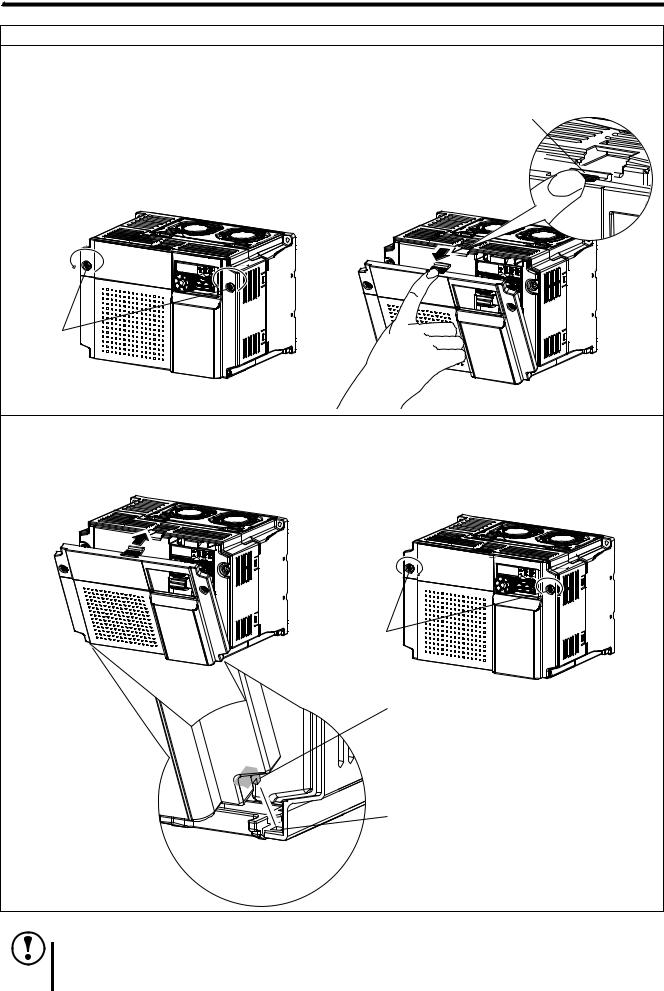
 Removal and reinstallation of the cover
Removal and reinstallation of the cover
FR-D720-238, 318 and FR-D740-120, 160
Removal (Example of FR-D740-160)
1)Loosen the installation screws of the front cover. (The screws cannot be removed.)
2)Remove the front cover by pulling it like the direction of arrow with holding the installation hook on the front cover.
Installation hook
1) |
2) |
Installation
screw
Reinstallation (Example of FR-D740-160)
1)Insert the two fixed hooks on the lower side of the front cover into the sockets of the inverter.
2)Tighten the installation screws on the front cover.
1) |
2) |
Installation screw
Fixed hook
Socket of the inverter
NOTE
Fully make sure that the front cover has been reinstalled securely.
The same serial number is printed on the capacity plate of the front cover and the rating plate of the inverter. Since these plates have the same serial numbers, always reinstall the removed cover onto the original inverter.
6
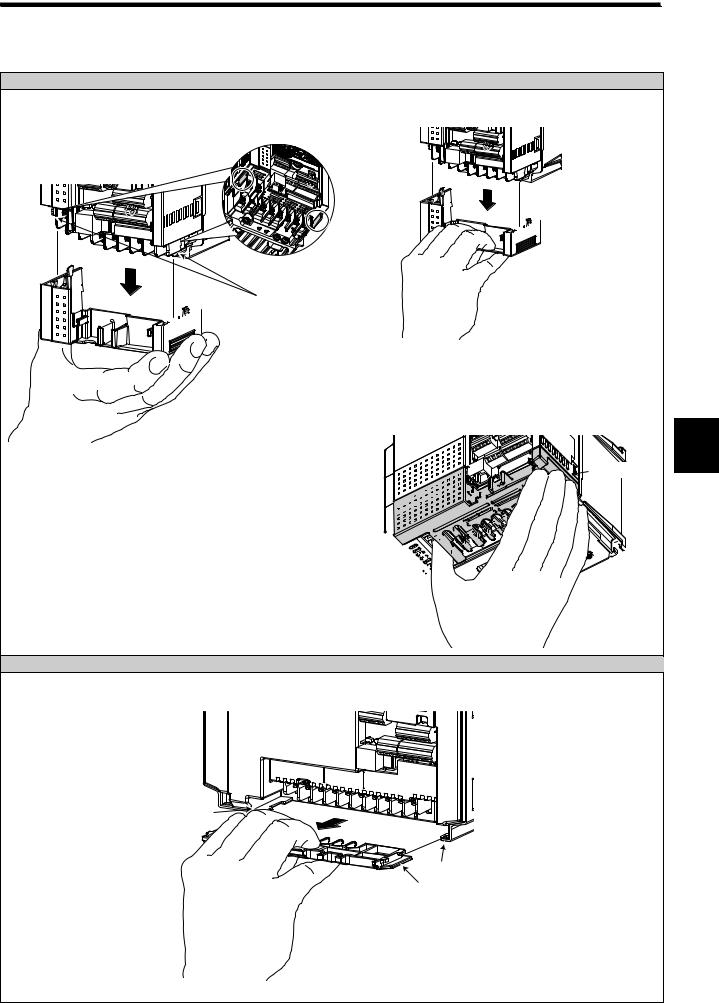
Removal and reinstallation of the cover 
1.3.2Wiring cover
Removal and reinstallation
FR-D720-165 or less and FR-D740-080 or less and FR-D720S-008 to 100
Hold the side of the wiring cover, and pull it downward for |
Also pull the wiring cover downward with holding a |
removal. |
frontal part of the wiring cover. |
To reinstall, fit the cover to the inverter along the guides. |
|

 Wiring cover
Wiring cover
Guide

 Wiring cover
Wiring cover
Example of FR-D740-036
See below diagram for wiring cover of FR-D720-165. Hold the dent of the wiring cover (marked with an arrow) with thumb and the side with other fingers and
pull downward for removal.
1
Example of FR-D740-036












 Wiring cover
Wiring cover 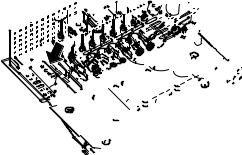

 OUTLINE
OUTLINE
FR-D720-238, 318 and FR-D740-120, 160
The cover can be removed easily by pulling it toward you.
To reinstall, fit the cover to the inverter along the guides.
Guide
Wiring cover
Example of FR-D740-160
7

 Installation of the inverter and enclosure design
Installation of the inverter and enclosure design
1.4Installation of the inverter and enclosure design
When an inverter panel is to be designed and manufactured, heat generated by contained equipment, etc., the environment of an operating place, and others must be fully considered to determine the panel structure, size and equipment layout. The inverter unit uses many semiconductor devices. To ensure higher reliability and long period of operation, operate the inverter in the ambient environment that completely satisfies the equipment specifications.
1.4.1Inverter installation environment
As the inverter installation environment should satisfy the standard specifications indicated in the following table, operation in any place that does not meet these conditions not only deteriorates the performance and life of the inverter, but also causes a failure. Refer to the following points and take adequate measures.
|
Environmental standard specifications of inverter |
|
|
|
|
Item |
Description |
|
Surrounding air |
-10 to +50°C (14°F to 122°F)(non-freezing) |
|
temperature |
||
|
||
Ambient humidity |
90%RH maximum (non-condensing) |
|
Atmosphere |
Free from corrosive and explosive gases, free from dust and dirt |
|
Maximum altitude |
1,000m (3280.80 feet) or less |
|
Vibration |
5.9m/s2 or less |
(1)Temperature
The permissible surrounding air temperature of the inverter is between -10 and +50°C (14°F to 122°F). Always operate the inverter within this temperature range. Operation outside this range will considerably shorten the service lives of the semiconductors, parts, capacitors and others. Take the following measures so that the surrounding air temperature of the inverter falls within the specified range.
1) Measures against high temperature
Use a forced ventilation system or similar cooling system. (Refer to page 10) Install the panel in an air-conditioned electrical chamber.
Block direct sunlight.
Provide a shield or similar plate to avoid direct exposure to the radiated heat and wind of a heat source. Ventilate the area around the panel well.
2)Measures against low temperature Provide a space heater in the enclosure.
Do not power off the inverter. (Keep the start signal of the inverter off.)
3)Sudden temperature changes
Select an installation place where temperature does not change suddenly. Avoid installing the inverter near the air outlet of an air conditioner.
If temperature changes are caused by opening/closing of a door, install the inverter away from the door.
(2)Humidity
Normally operate the inverter within the 45 to 90% range of the ambient humidity. Too high humidity will pose problems of reduced insulation and metal corrosion. On the other hand, too low humidity may produce a spatial electrical breakdown. The insulation distance specified in JEM1103 "Control Equipment Insulator" is defined as humidity 45 to 85%.
1) Measures against high humidity
Make the panel enclosed, and provide it with a hygroscopic agent. Take dry air into the enclosure from outside.
Provide a space heater in the enclosure.
2)Measures against low humidity
What is important in fitting or inspection of the unit in this status is to discharge your body (static electricity) beforehand and keep your body from contact with the parts and patterns, besides blowing air of proper humidity into the enclosure from outside.
3)Measures against condensation
Condensation may occur if frequent operation stops change the in-enclosure temperature suddenly or if the outsideair temperature changes suddenly.
Condensation causes such faults as reduced insulation and corrosion. Take the measures against high humidity in 1).
Do not power off the inverter. (Keep the start signal of the inverter off.)
8

Installation of the inverter and enclosure design 
(3)Dust, dirt, oil mist
Dust and dirt will cause such faults as poor contact of contact points, reduced insulation or reduced cooling effect due to moisture absorption of accumulated dust and dirt, and in-enclosure temperature rise due to clogged filter. In the atmosphere where conductive powder floats, dust and dirt will cause such faults as malfunction, deteriorated insulation and short circuit in a short time.
Since oil mist will cause similar conditions, it is necessary to take adequate measures.
Countermeasures
Place in a totally enclosed enclosure.
Take measures if the in-enclosure temperature rises. (Refer to page 10) Purge air.
Pump clean air from outside to make the in-enclosure pressure higher than the outside-air pressure.
(4)Corrosive gas, salt damage
If the inverter is exposed to corrosive gas or to salt near a beach, the printed board patterns and parts will corrode or the relays and switches will result in poor contact.
In such places, take the measures given in Section 3.
(5)Explosive, flammable gases
As the inverter is non-explosion proof, it must be contained in an explosion proof enclosure. In places where explosion may be caused by explosive gas, dust or dirt, an enclosure cannot be used unless it structurally complies with the guidelines and has passed the specified tests. This makes the enclosure itself expensive (including the test charges). The best way is to avoid installation in such places and install the inverter in a non-hazardous place.
(6)Highland
Use the inverter at the altitude of within 1000m (3280.80 feet). If it is used at a higher place, it is likely that thin air will reduce the cooling effect and low air pressure will deteriorate dielectric strength.
Maximum 1000m (3280.80feet) above sea level for standard operation. After that derate by 3% for every extra 500m (1640.40feet) up to 2500m (8202feet) (91%).
(7)Vibration, impact
The vibration resistance of the inverter is up to 5.9m/s2 at 10 to 55Hz frequency and 1mm amplitude. Vibration or impact, if less than the specified value, applied for a long time may make the mechanism loose or cause poor contact to the connectors. Especially when impact is imposed repeatedly, caution must be taken as the part pins are likely to break.
Countermeasures
Provide the panel with rubber vibration isolators.
Strengthen the structure to prevent the enclosure from resonance.
Install the enclosure away from sources of vibration.
1 OUTLINE
9
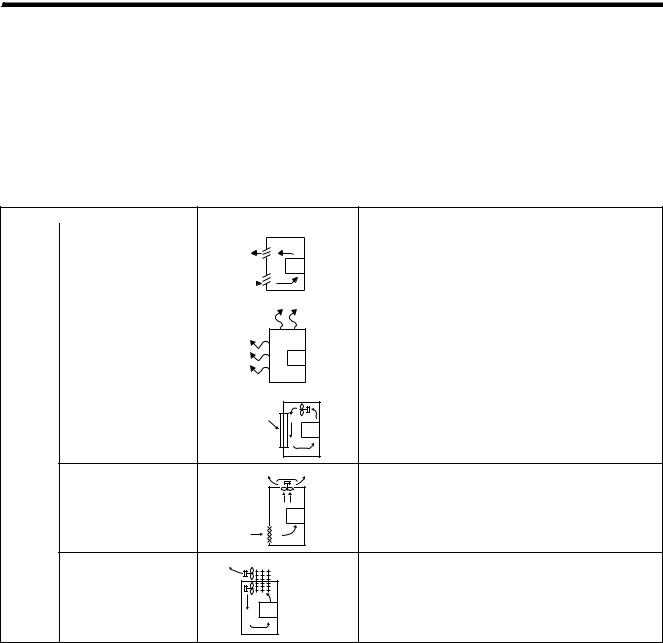
 Installation of the inverter and enclosure design
Installation of the inverter and enclosure design
1.4.2Cooling system types for inverter enclosure
From the enclosure that contains the inverter, the heat of the inverter and other equipment (transformers, lamps, resistors, etc.) and the incoming heat such as direct sunlight must be dissipated to keep the in-enclosure temperature lower than the permissible temperatures of the in-panel equipment including the inverter.
The cooling systems are classified as follows in terms of the cooling calculation method.
1)Cooling by natural heat dissipation from the enclosure surface (totally enclosed type)
2)Cooling by heat sink (aluminum fin, etc.)
3)Cooling by ventilation (forced ventilation type, pipe ventilation type)
4)Cooling by heat exchanger or cooler (heat pipe, cooler, etc.)
Cooling System |
Enclosure Structure |
Comment |
|||
|
Natural ventilation |
|
|
|
Low in cost and generally used, but the enclosure size |
|
|
|
|
increases as the inverter capacity increases. For relatively |
|
|
(enclosed, open type) |
|
|
INV |
|
|
|
|
small capacities. |
||
|
|
|
|
|
|
Natural |
|
|
|
|
|
|
|
|
|
|
|
cooling |
|
|
|
Being a totally enclosed type, the most appropriate for hostile |
|
|
Natural ventilation |
|
|
|
|
|
|
|
|
environment having dust, dirt, oil mist, etc. The enclosure size |
|
|
(totally enclosed type) |
|
|
|
|
|
|
|
INV |
increases depending on the inverter capacity. |
|
|
|
|
|
||
|
|
|
|
|
|
|
Heatsink cooling |
Heatsink |
Having restrictions on the heatsink mounting position and |
||
|
|
|
INV |
area, and designed for relative small capacities. |
|
|
|
|
|
||
Forced |
Forced ventilation |
For general indoor installation. Appropriate for enclosure |
|
downsizing and cost reduction, and often used. |
|||
cooling |
INV |
||
|
|
 Heat pipe
Heat pipe
Heat pipe |
Totally enclosed type for enclosure downsizing. |
INV
10
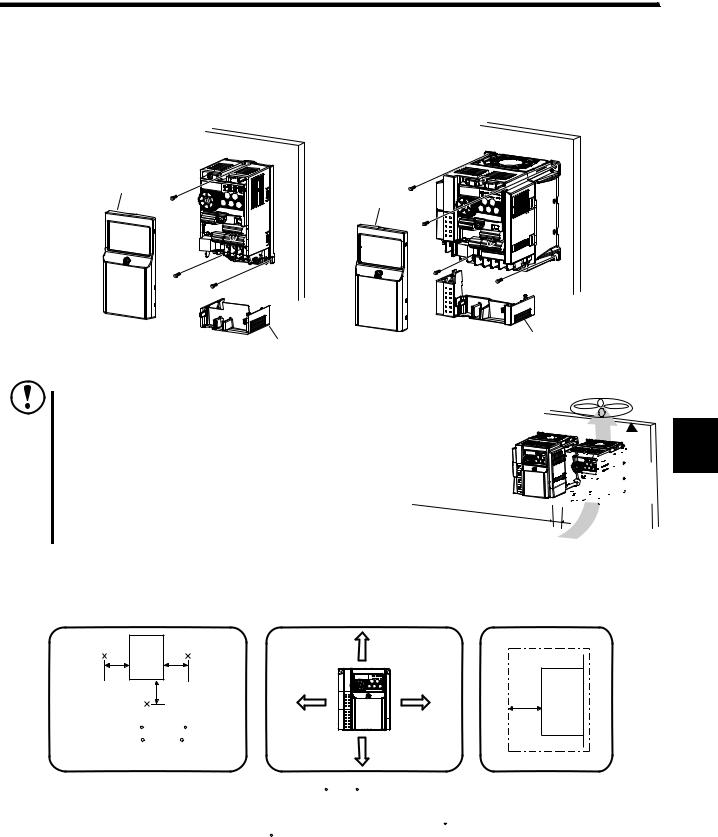
Installation of the inverter and enclosure design 
1.4.3Inverter placement
(1)Installation of the inverter Enclosure surface mounting
Remove the front cover and wiring cover to fix the inverter to the surface.
FR-D720-008 to 042 |
FR-D720-070 or more |
FR-D720S-008 to 042 |
FR-D740-012 or more |
|
FR-D720S-070, 100 |
Front cover |
|
|
Front cover |
Wiring cover
Wiring cover
NOTE
When encasing multiple inverters, install them in parallel as a cooling measure.
Install the inverter vertically.
Refer to the clearances below.




 Vertical
Vertical
(2)Clearances around inverter
To ensure ease of heat dissipation and maintenance, leave at least the shown clearances around the inverter. At least the following clearances are required under the inverter as a wiring space, and above the inverter as a heat dissipation space.
Surrounding air temperature and humidity |
Clearances (front) |
Clearances (side) |
|
|
Measurement |
|
10cm |
|
|
|
position |
|
(3.94inches) |
|
|
Inverter |
5cm |
|
or more |
|
|
5cm |
1cm |
1cm |
|
|
|
(1.97inches) |
(1.97inches) |
|
|
||
(0.39inches) |
(0.39inches) |
1cm |
|
||
|
|
|
|||
Measurement |
5cm (1.97inches) |
or more* |
or more* |
(0.39 |
Inverter |
|
|
inches) |
|||
position |
|
|
|
|
|
|
|
|
|
|
|
|
|
|
|
or more |
|
Temperature: -10 C to +50 C |
|
|
* |
|
|
|
|
|
|
||
(14 F to 122 F) |
|
10cm |
|
|
|
Humidity: 90% RH maximum |
|
(3.94inches) |
|
|
|
|
or more |
|
|
||
|
|
|
|
|
|
Leave enough clearances and take |
* When using the inverters at the surrounding air |
* 5cm (1.97inches) or more for |
|||
cooling measures. |
|
temperature of 40 C (104 F) or less, the inverters can |
the FR-D720-238 or more |
||
|
|
be installed without any clearance between them |
and FR-D740-120 or more |
||
|
|
(0cm (0inch) clearance). |
|
|
|
|
|
When surrounding air temperature exceeds 40 C |
|
|
|
|
|
(104 F), clearances between the inverters should be |
|
|
|
|
|
1cm (0.39inches) or more (5cm (1.97inches) or more |
|
|
|
|
|
for the FR-D720-238 or more and FR-D740-120 or |
|
|
|
|
|
more). |
|
|
|
(3)Inverter mounting orientation
Mount the inverter on a wall as specified. Do not mount it horizontally or any other way.
(4)Above inverter
Heat is blown up from inside the inverter by the small fan built in the unit. Any equipment placed above the inverter should be heat resistant.
1 OUTLINE
11
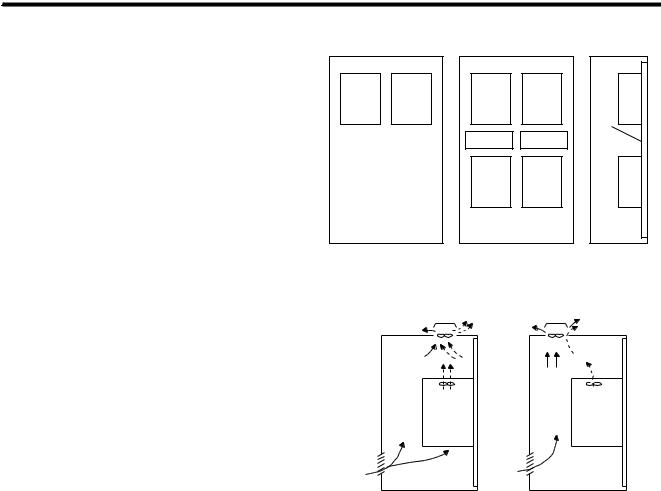
 Installation of the inverter and enclosure design
Installation of the inverter and enclosure design
(5) Arrangement of multiple inverters
When multiple inverters are placed in the same enclosure, generally arrange them horizontally as shown in the right figure (a). When it is inevitable to arrange
them vertically to minimize space, take such measures as |
Inverter Inverter |
Inverter |
Inverter |
|
|
|
|
|
|
to provide guides since heat from the bottom inverters |
|
|
|
|
can increase the temperatures in the top inverters, |
|
Guide |
Guide |
Guide |
causing inverter failures. |
|
|
|
|
|
|
Inverter |
Inverter |
|
When mounting multiple inverters, fully take caution not |
|
|
|
|
to make the surrounding air temperature of the inverter |
|
|
|
|
higher than the permissible value by providing ventilation |
Enclosure |
Enclosure |
|
|
and increasing the enclosure size. |
(a) Horizontal arrangement |
|
(b) Vertical arrangement |
|
|
Arrangement of multiple inverters |
|
||
(6)Arrangement of ventilation fan and inverter
Heat generated in the inverter is blown up from the bottom of |
|
|
the unit as warm air by the cooling fan. When installing a |
|
|
ventilation fan for that heat, determine the place of ventilation |
|
|
fan installation after fully considering an air flow. (Air passes |
|
|
through areas of low resistance. Make an airway and airflow |
|
|
plates to expose the inverter to cool air.) |
Inverter |
Inverter |
|
<Good example> |
<Bad example> |
Arrangement of ventilation fan and inverter
12
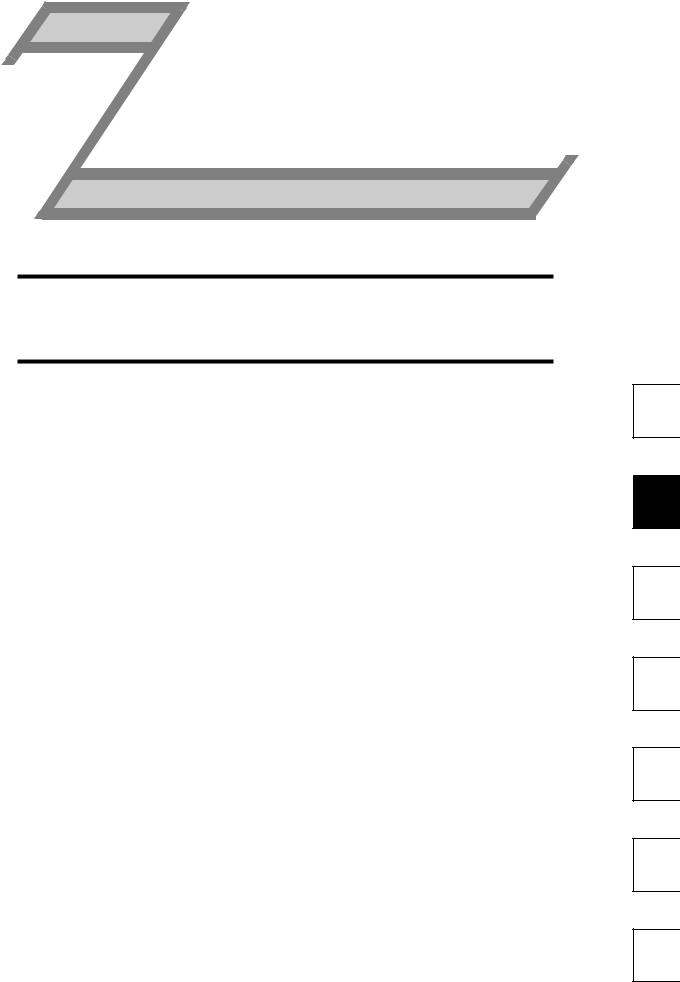
2 WIRING
This chapter describes the basic "WIRING" for use of this product.
Always read the instructions before using the equipment
2.1 |
Wiring............................................................................................. |
14 |
2.2 |
Main circuit terminal specifications ............................................ |
15 |
2.3 |
Control circuit specifications ...................................................... |
20 |
2.4 |
Connection of stand-alone option unit ....................................... |
31 |
1
2
3
4
5
6
7
13
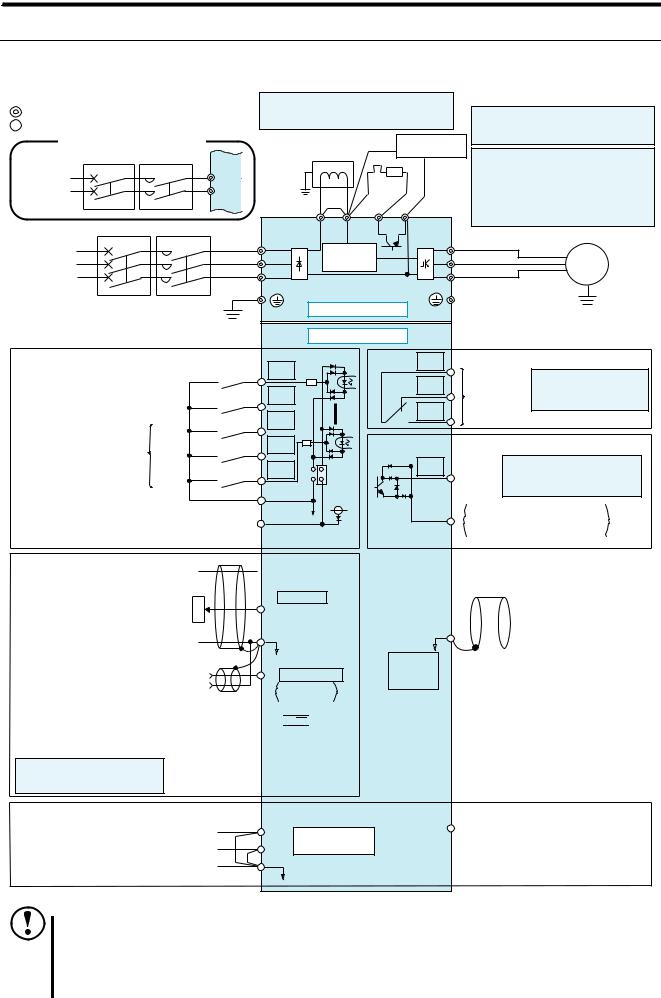
 Wiring
Wiring
2.1Wiring
2.1.1Terminal connection diagram
Sink logic |
*1. DC reactor (FR-HEL) |
Main circuit terminal |
|
When connecting a DC reactor, remove the |
*6 |
A brake transistor is not built-in to the |
|||
Control circuit terminal |
|
jumper across P1-P/+ |
|
|
|
FR-D720-008, 014 and FR-D720S-008, |
|
|
|
|
|
|
|
||
Single-phase power input |
|
|
|
Brake unit |
|
014. |
|
|
|
|
|
|
|||
MCCB |
MC |
|
|
|
(Option) |
*7 Brake resistor (FR-ABR, MRS type, MYS |
|
|
|
|
|
||||
Single-phase |
R/L1 |
|
*1 |
|
R |
|
type) |
Earth |
|
|
|
Install a thermal relay to prevent an |
|||
AC power |
|
|
|
|
|
||
S/L2 |
|
*7 |
|
overheat and burnout of the brake resistor. |
|||
(Ground) |
|
|
|||||
supply |
|
|
|||||
|
|
|
|
|
(The brake resistor can not be connected |
||
|
|
|
|
|
|
||
|
|
|
|
|
|
|
|
|
|
Jumper |
|
PR |
N/- |
|
to the FR-D720-008, 014 and FR-D720S- |
|
|
|
|
|
*6 |
|
008, 014.) |
MCCB |
MC |
P1 |
P/+ |
|
|
|
|
|
|
|
Motor |
||||
|
|
|
|
|
U |
|
|
Three-phase |
|
R/L1 |
Inrush current |
|
|
||
|
|
|
|
||||
|
|
V |
|
|
|||
AC power |
|
S/L2 |
|
|
|||
|
limit circuit |
|
|
IM |
|||
supply |
|
T/L3 |
|
W |
|
||
|
|
|
|
|
|||
|
Earth |
|
Main circuit |
|
Earth (Ground) |
||
|
(Ground) |
|
|
||||
|
|
|
|
|
|
||
|
|
|
|
|
|
|
|
Control input signals (No voltage input allowed)
|
Terminal functions vary |
Forward |
|
|
rotation start |
||
|
with the input terminal |
Reverse |
|
|
assignment (Pr. 178 to |
||
|
rotation start |
||
|
Pr. 182) |
||
|
|
High |
|
|
|
|
|
|
|
|
speed |
|
Multi-speed selection Middle |
||
|
|
|
speed |
|
*2 When using terminals PC- |
Low |
|
|
SD as a 24VDC power |
|
|
|
|
speed |
|
|
supply, take care not to |
|
|
|
|
|
|
|
short across terminals |
|
Contact input common |
|
PC-SD. |
|
|
|
|
|
|
|
|
|
24VDC power supply |
|
(Common for external power supply transistor) |
||
|
|
Control circuit |
|
|
|
|
STF |
|
|
C |
|
|
Relay output |
|
|
|
|
|
Terminal functions vary |
|
|
|
|
B |
|
|
|
STR |
|
|
Relay output |
by Pr. 192 A,B,C terminal |
||
|
|
|
||||
|
|
|
|
|||
|
|
|
|
|
function selection |
|
|
|
|
|
(Fault output) |
||
|
|
|
A |
|
||
RH |
|
|
|
|
|
|
|
|
|
|
|
|
|
RM |
SOURCE |
SINK |
|
|
|
Open collector output |
SD |
|
|
selection |
|||
RL |
|
|
RUN |
|
Terminal functions vary by |
|
|
|
|
|
Running |
Pr. 190 RUN terminal function |
|
|
|
|
|
|
|
|
|
|
24V |
|
|
|
|
PC *2 |
|
|
SE |
Open collector output common |
||
|
|
|
|
Sink/source common |
||
Frequency setting signals (Analog)
|
|
3 |
|
|
|
|
*3 Terminal input specifications |
Frequency |
|
|
|
|
|
can be changed by analog |
setting |
|
|
|
|
|
input specifications |
|
|
|
|
2 |
|
potentiometer |
|
|
|
|||
switchover (Pr. 73). |
|
|
|
|||
1/2W1kΩ |
|
|
|
|
|
|
Terminal 10 and terminal 2 |
|
|
|
|
|
|
are used as PTC input |
*5 |
|
|
|
|
|
terminal (Pr. 561). |
1 |
|
|
|
||
|
|
|
|
|||
|
|
|
|
|
|
|
*4 Terminal input |
|
|
|
|
|
|
specifications can be |
Terminal 4 |
|
||||
changed by analog input |
input |
(+) |
|
|||
specifications switchover |
(Current |
(-) |
|
|
||
(Pr. 267). Set the |
|
|
||||
input) |
|
|
|
|
|
|
voltage/current input |
|
|
|
|
|
|
|
|
|
|
|
|
|
switch in the "V" position |
|
|
|
|
|
|
to select voltage input (0 |
|
|
|
|
|
|
to 5V/0 to10V) and "I" |
|
|
|
|
|
|
(initial value) to select |
|
|
|
|
|
|
current input (4 to 20mA). |
|
|
|
|
|
|
|
|
|
|
|
|
|
*5 It is recommended to use 2W1kΩ when the frequency setting signal is changed frequently.
Safety stop signal
Output shutoff (Line 1)
Output shutoff (Line 2)
Common terminal
 10(+5V)
10(+5V)
2 0 to 5VDC *3
(0 to 10VDC)
5(Analog common)
4 4 to 20mADC
0 to 5VDC |
*4 |
0 to 10VDC |
V 

 I
I
Voltage/current
input switch *4
Shorting
wire S1
 Output shutoff
Output shutoff
S2
 circuit
circuit
SC
AM
 (+)
(+)
5  (-)
(-)
Analog signal output (0 to 10VDC)
PU connector
SO
SafetyFor manufacturermonitor outputset ing*8
*8 Common terminal of terminal SO is terminal SC. (Connected to terminal SD inside of the inverter.)
NOTE
To prevent a malfunction caused by noise, separate the signal cables more than 10cm (3.94inches) from the power cables. Also separate the main circuit wire of the input side and the output side.
After wiring, wire offcuts must not be left in the inverter.
Wire offcuts can cause an alarm, failure or malfunction. Always keep the inverter clean. When drilling mounting holes in an enclosure etc., take care not to allow chips and other foreign matter to enter the inverter.
The output of the single-phase power input specification is three-phase 200V.
14
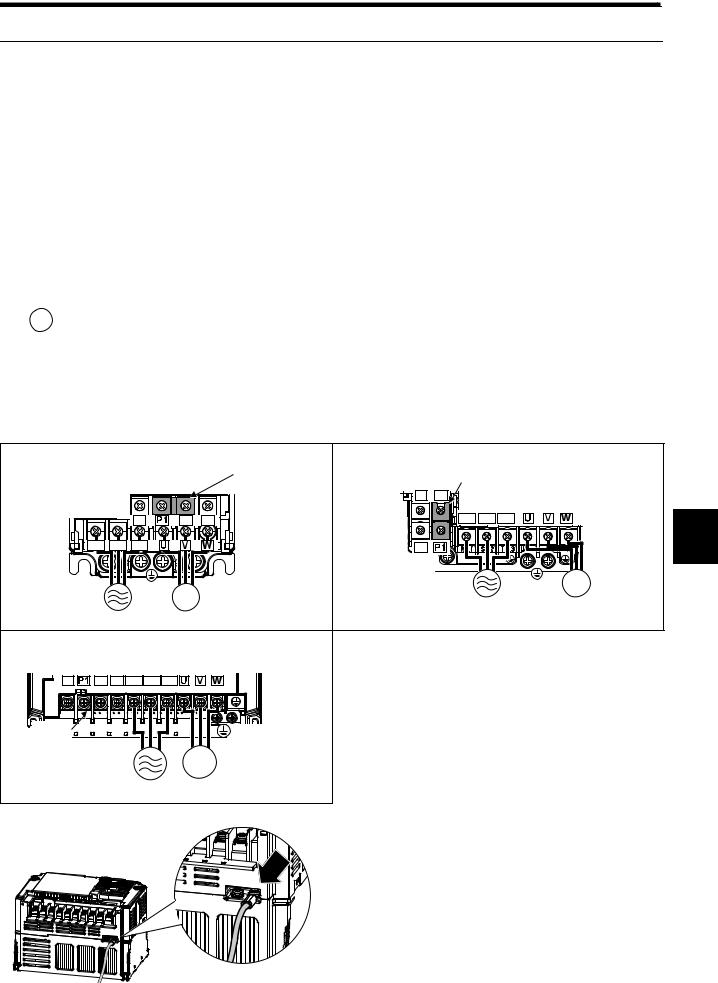
Main circuit terminal specifications 
2.2Main circuit terminal specifications
2.2.1Specification of main circuit terminal
Terminal |
Terminal Name |
Description |
||||||||
Symbol |
||||||||||
|
|
|||||||||
R/L1, |
|
Connect to the commercial power supply. |
||||||||
S/L2, |
AC power input |
Keep these terminals open when using the high power factor converter (FR-HC) or |
||||||||
T/L3 * |
|
power regeneration common converter (FR-CV). |
||||||||
U, V, W |
Inverter output |
Connect a three-phase squirrel-cage motor. |
||||||||
|
|
|
|
|
|
|
|
|
Connect a brake resistor (FR-ABR, MRS type, MYS type) across terminals P/+ and PR. |
|
P/+, PR |
Brake resistor connection |
(The brake resistor can not be connected to the FR-D720-008 and 014 and FR- |
||||||||
|
|
|
|
|
|
|
|
|
D720S-008 and 014.) |
|
P/+, N/- |
Brake unit connection |
Connect the brake unit (FR-BU2), power regeneration common converter (FR-CV) |
||||||||
or high power factor converter (FR-HC). |
||||||||||
|
|
|
|
|
|
|
|
|
||
P/+, P1 |
DC reactor connection |
Remove the jumper across terminals P/+ and P1 and connect a DC reactor. |
||||||||
|
|
|
|
|
|
|
|
Earth (Ground) |
For earthing (grounding) the inverter chassis. Must be earthed (grounded). |
|
|
|
|
|
|
|
|
|
|||
|
|
|
|
|
|
|
|
|
|
|
|
|
|
|
|
|
|
|
|
|
|
* When using single-phase power input, terminals are R/L1 and S/L2.
2.2.2Terminal arrangement of the main circuit terminal, power supply and the motor wiring
Three-phase 200V class
FR-D720-008 to 042 |
FR-D720-070 to 165 |
Jumper |
Jumper |
Screw size (M3.5) |
|
|
N/- P/+ |
|
Screw size (M4) |
|
|
N/- |
P/+ |
PR |
R/L1 S/L2 T/L3 |
|
2 |
R/L1 |
S/L2 |
T/L3 |
|
|
|
|
|
|
|
PR |
|
WIRING |
|||
|
|
Screw size |
|
|
Screw size |
IM |
|
|
|
|
|
|
|||
|
|
(M3.5) |
IM |
|
(M4) |
Motor |
|
|
|
|
Power supply |
|
|||
|
|
|
|
|
|
||
Power supply |
Motor |
|
|
|
|
||
FR-D720-238, 318 |
|
|
|
|
|
|
|
Screw size (M5)
N/- |
P/+ PR R/L1S/L2 T/L3 |
Jumper |
Screw size (M5) |
|
|
|
IM |
Power supply |
Motor |
* For wiring to earth (ground) terminals of FR-D720-238 and 318, use the earthing cable wiring space (marked with an arrow) to route the wires.
15
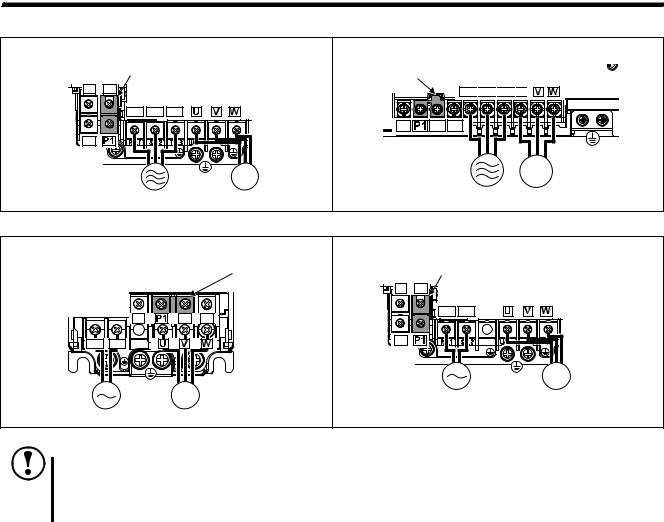
 Main circuit terminal specifications
Main circuit terminal specifications
Three-phase 400V class
FR-D740-012 to 080
|
Jumper |
|
|
N/- |
P/+ |
|
|
|
Screw size (M4) |
|
|
|
R/L1 S/L2 T/L3 |
|
|
PR |
|
|
|
|
Screw size |
IM |
|
|
Power supply |
(M4) |
Motor |
FR-D740-120, 160
Jumper |
Screw size (M4) |
R/L1
 S/L2
S/L2
 T/L3
T/L3



N/- |
P/+ PR |
|
|
|
|
|
Screw size |
|
|
IM |
(M4) |
|
|
|
|
|
Power supply |
Motor |
|
Single-phase 200V class
FR-D720S-008 to 042 |
FR-D720S-070, 100 |
Jumper |
Jumper |
Screw size (M3.5) |
N/- P/+ |
|
|
|
Screw size (M4) |
|
N/- |
P/+ |
R/L1 S/L2 |
|
|
|
PR |
|
|
||
R/L1 |
S/L2 |
|
PR |
|
|
|
|
|
|
||
|
Screw size |
|
Screw size |
IM |
|
|
IM |
Power supply |
(M4) |
Motor |
|
|
(M3.5) |
||||
Power supply |
Motor |
|
|
|
|
NOTE
Make sure the power cables are connected to the R/L1, S/L2, T/L3. (Phase need not be matched.) Never connect the power cable to the U, V, W of the inverter. Doing so will damage the inverter.
Connect the motor to U, V, W. Turning on the forward rotation switch (signal) at this time rotates the motor counterclockwise when viewed from the load shaft.
16
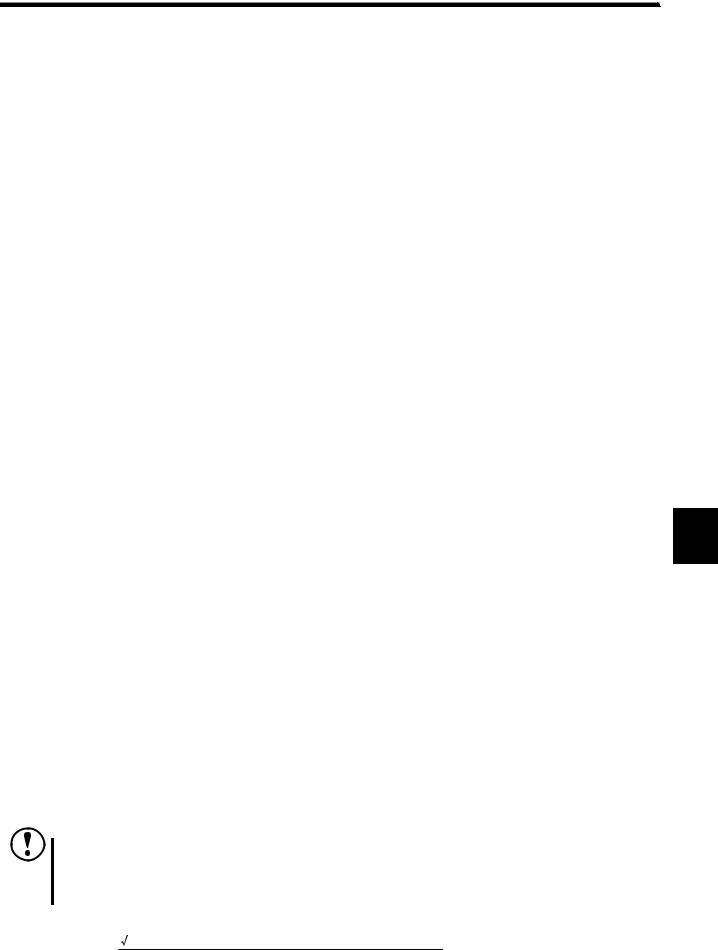
Main circuit terminal specifications 
2.2.3Cables and wiring length
(1)Applied wire size
Select the recommended cable size to ensure that a voltage drop will be 2% max.
If the wiring distance is long between the inverter and motor, a main circuit cable voltage drop will cause the motor torque to decrease especially at the output of a low frequency.
The following table indicates a selection example for the wiring length of 20m (65.61feet).
Three-phase 200V class (when input power supply is 220V)
|
|
|
Crimping |
|
|
|
Cable Size |
|
|
|
|||
|
|
|
HIV Cables, etc. (mm2) 1 |
|
|
PVC Cables, etc. (mm2) |
|||||||
Applicable Inverter |
Terminal |
Tightening |
Terminal |
AWG 2 |
|||||||||
Screw |
Torque |
|
|
|
|
|
|
|
|
3 |
|
||
Model |
R/L1 |
|
R/L1 |
|
Earth |
R/L1 |
|
R/L1 |
|
Earth |
|||
Size 4 |
N·m |
U, V, W |
U, V, W |
U, V, W |
U, V, W |
||||||||
|
S/L2 |
S/L2 |
(ground) |
S/L2 |
S/L2 |
(ground) |
|||||||
|
|
|
|||||||||||
|
|
|
T/L3 |
|
T/L3 |
|
cable |
T/L3 |
|
T/L3 |
|
cable |
|
FR-D720-008 to 042 |
M3.5 |
1.2 |
2-3.5 |
2-3.5 |
2 |
2 |
2 |
14 |
14 |
2.5 |
2.5 |
2.5 |
|
FR-D720-070, 100 |
M4 |
1.5 |
2-4 |
2-4 |
2 |
2 |
2 |
14 |
14 |
2.5 |
2.5 |
2.5 |
|
FR-D720-165 |
M4 |
1.5 |
5.5-4 |
5.5-4 |
3.5 |
3.5 |
3.5 |
12 |
12 |
4 |
4 |
4 |
|
FR-D720-238 |
M5 |
2.5 |
5.5-5 |
5.5-5 |
5.5 |
5.5 |
5.5 |
10 |
10 |
6 |
6 |
6 |
|
FR-D720-318 |
M5 |
2.5 |
14-5 |
8-5 |
14 |
8 |
5.5 |
6 |
8 |
16 |
10 |
6 |
|
Three-phase 400V class (when input power supply is 440V)
|
|
|
Crimping |
|
|
|
Cable Size |
|
|
|
|||
|
|
|
HIV Cables, etc. (mm2) 1 |
|
|
PVC Cables, etc. (mm2) |
|||||||
Applicable Inverter |
Terminal |
Tightening |
Terminal |
AWG 2 |
|||||||||
Screw |
Torque |
|
|
|
|
|
|
|
|
3 |
|
||
Model |
R/L1 |
|
R/L1 |
|
Earth |
R/L1 |
|
R/L1 |
|
Earth |
|||
Size 4 |
N·m |
U, V, W |
U, V, W |
U, V, W |
U, V, W |
||||||||
|
S/L2 |
S/L2 |
(ground) |
S/L2 |
S/L2 |
(ground) |
|||||||
|
|
|
|||||||||||
|
|
|
T/L3 |
|
T/L3 |
|
cable |
T/L3 |
|
T/L3 |
|
cable |
|
FR-D740-012 to 080 |
M4 |
1.5 |
2-4 |
2-4 |
2 |
2 |
2 |
14 |
14 |
2.5 |
2.5 |
2.5 |
|
FR-D740-120 |
M4 |
1.5 |
5.5-4 |
2-4 |
3.5 |
2 |
3.5 |
12 |
14 |
4 |
2.5 |
4 |
|
FR-D740-160 |
M4 |
1.5 |
5.5-4 |
5.5-4 |
3.5 |
3.5 |
3.5 |
12 |
12 |
4 |
4 |
4 |
|
Single-phase 200V class (when input power supply is 220V)
|
|
|
Crimping |
|
|
|
Cable Size |
|
|
|
|||
|
|
|
HIV Cables, etc. (mm2) 1 |
|
|
PVC Cables, etc. (mm2) |
|||||||
Applicable Inverter |
Terminal |
Tightening |
Terminal |
AWG 2 |
|||||||||
Screw |
Torque |
|
|
|
|
|
|
|
|
3 |
|
||
Model |
|
|
|
|
Earth |
|
|
|
|
Earth |
|||
Size 4 |
N·m |
R/L1 |
U, V, W |
R/L1 |
U, V, W |
R/L1 |
U, V, W |
R/L1 |
U, V, W |
||||
|
(ground) |
(ground) |
|||||||||||
|
|
|
|||||||||||
|
|
|
S/L2 |
|
S/L2 |
|
cable |
S/L2 |
|
S/L2 |
|
cable |
|
|
|
|
|
|
|
|
|
|
|
|
|||
FR-D720S-008 to 042 |
M3.5 |
1.2 |
2-3.5 |
2-3.5 |
2 |
2 |
2 |
14 |
14 |
2.5 |
2.5 |
2.5 |
|
FR-D720S-070 |
M4 |
1.5 |
2-4 |
2-4 |
2 |
2 |
2 |
14 |
14 |
2.5 |
2.5 |
2.5 |
|
FR-D720S-100 |
M4 |
1.5 |
5.5-4 |
2-4 |
3.5 |
2 |
3.5 |
12 |
14 |
4 |
2.5 |
4 |
|
1 The cable size is that of the cable (HIV cable (600V class 2 vinyl-insulated cable) etc.) with continuous maximum permissible temperature of 75°C (167°F). Assumes that the surrounding air temperature is 50°C (122°F) or less and the wiring distance is 20m (65.61feet) or less.
2 The recommended cable size is that of the cable (THHW cable) with continuous maximum permissible temperature of 75°C (167°F). Assumes that the surrounding air temperature is 40°C (104°F) or less and the wiring distance is 20m (65.61feet) or less.
(Selection example for use mainly in the United States.)
3 The recommended cable size is that of the cable (THHW cable) with continuous maximum permissible temperature of 70°C (158°F). Assumes that the surrounding air temperature is 40°C (104°F) or less and the wiring distance is 20m (65.61feet) or less.
(Selection example for use mainly in Europe.)
4 The terminal screw size indicates the terminal size for R/L1, S/L2, T/L3, U, V, W, PR, P/+, N/-, P1 and a screw for earthing (grounding).
For single-phase power input, the terminal screw size indicates the size of terminal screw for R/L1, S/L2, U, V, W, PR, P/+, N/-, P1 and a screw for earthing (grounding).
NOTE
Tighten the terminal screw to the specified torque. A screw that has been tightened too loosely can cause a short circuit or malfunction. A screw that has been tightened too tightly can cause a short circuit or malfunction due to the unit breakage.
Use crimping terminals with insulation sleeve to wire the power supply and motor.
The line voltage drop can be calculated by the following formula:
3 × wire resistance[mΩ/m] × wiring distance[m] × current[A]
line voltage drop [V]=
1000
Use a larger diameter cable when the wiring distance is long or when it is desired to decrease the voltage drop (torque reduction) in the low speed range.
2 WIRING
17
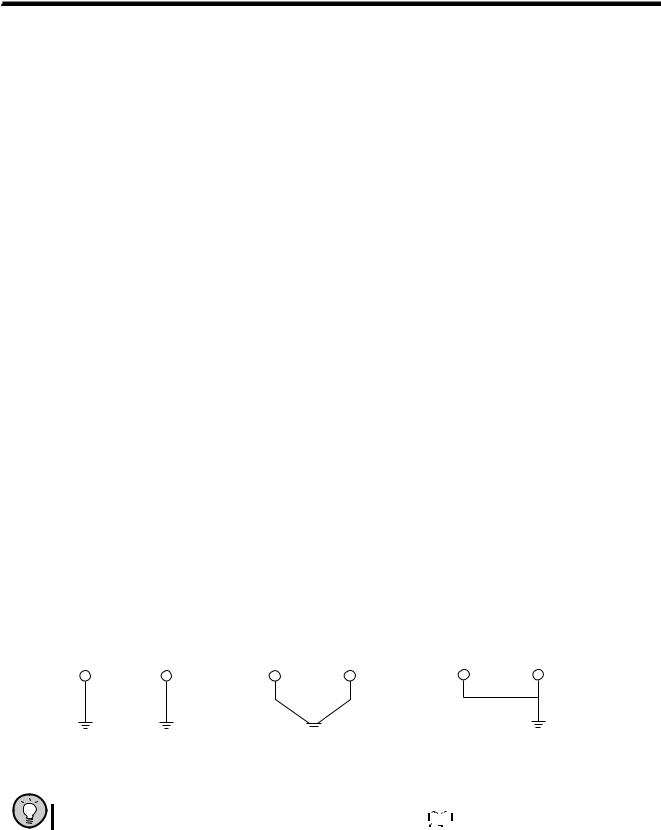
 Main circuit terminal specifications
Main circuit terminal specifications
(2)Earthing (Grounding) precautions
Always earth (ground) the motor and inverter.
1)Purpose of earthing (grounding)
Generally, an electrical apparatus has an earth (ground) terminal, which must be connected to the ground before use. An electrical circuit is usually insulated by an insulating material and encased. However, it is impossible to manufacture an insulating material that can shut off a leakage current completely, and actually, a slight current flow into the case. The purpose of earthing (grounding) the case of an electrical apparatus is to prevent operator from getting an electric shock from this leakage current when touching it.
To avoid the influence of external noises, this earthing (grounding) is important to audio equipment, sensors, computers and other apparatuses that handle low-level signals or operate very fast.
2)Earthing (grounding) methods and earthing (grounding) work
As described previously, earthing (grounding) is roughly classified into an electrical shock prevention type and a noiseaffected malfunction prevention type. Therefore, these two types should be discriminated clearly, and the following work must be done to prevent the leakage current having the inverter's high frequency components from entering the malfunction prevention type earthing (grounding):
(a)Where possible, use independent earthing (grounding) for the inverter. If independent earthing (grounding) (I) is impossible, use joint earthing (grounding) (II) where the inverter is connected with the other equipment at an earthing (grounding) point. Joint earthing (grounding) as in (III) must be avoided as the inverter is connected with the other equipment by a common earth (ground) cable.
Also a leakage current including many high frequency components flows in the earth (ground) cables of the inverter and inverter-driven motor. Therefore, they must use the independent earthing (grounding) method and be separated from the earthing (grounding) of equipment sensitive to the aforementioned noises.
In a tall building, it will be a good policy to use the noise malfunction prevention type earthing (grounding) with steel frames and carry out electric shock prevention type earthing (grounding) in the independent earthing (grounding) method.
(b)This inverter must be earthed (grounded). Earthing (Grounding) must conform to the requirements of national and local safety regulations and electrical codes. (NEC section 250, IEC 536 class 1 and other applicable standards). Use an neutral-point earthed (grounded) power supply for 400V class inverter in compliance with EN standard.
(c)Use the thickest possible earth (ground) cable. The earth (ground) cable should be of not less than the size indicated in the table on the previous page 17.
(d)The earthing (grounding) point should be as near as possible to the inverter, and the earth (ground) cable length should be as short as possible.
(e)Run the earth (ground) cable as far away as possible from the I/O wiring of equipment sensitive to noises and run them in parallel in the minimum distance.
|
|
Other |
|
|
|
Other |
|
Inverter |
|
Other |
Inverter |
|
|
Inverter |
|
|
|
||||
|
equipment |
|
|
equipment |
|
|
equipment |
|||
|
|
|
|
|
|
|
|
|||
|
|
|
|
|
|
|
|
|
|
|
|
|
|
|
|
|
(III)Common earthing |
Not allowed |
|
(I)Independent earthing |
Best |
(II)Common earthing |
Good |
|||||
|
|
|||||||
POINT
To be compliant with the European Directive (Low Voltage Directive),  refer to the Installation Guideline.
refer to the Installation Guideline.
18
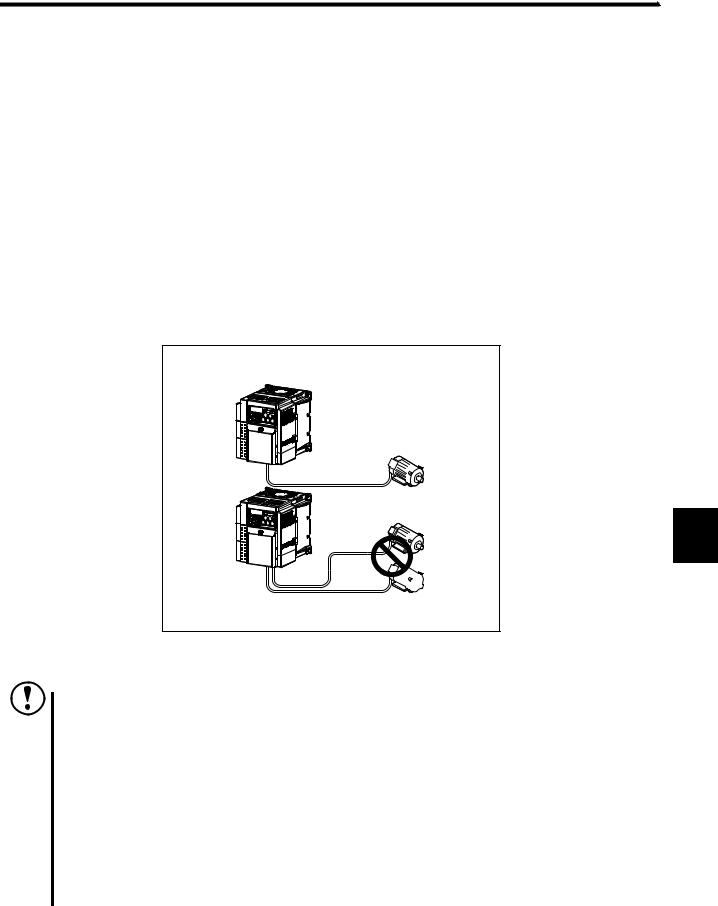
Main circuit terminal specifications 
(3)Total wiring length
The overall wiring length for connection of a single motor or multiple motors should be within the value in the table below.
200V class
|
Pr. 72 PWM frequency |
|
|
|
|
|
|
selection Setting |
008 |
014 |
025 |
042 |
070 or More |
|
(carrier frequency) |
|
|
|
|
|
|
1 (1kHz) or less |
200m |
200m |
300m |
500m |
500m |
|
(656.19feet) |
(656.19feet) |
(984.25feet) |
(1640.42feet) |
(1640.42feet) |
|
|
|
|||||
|
2 to15 |
30m |
100m |
200m |
300m |
500m |
|
(2kHz to 14.5kHz) |
(98.42feet) |
(328.08feet) |
(656.19feet) |
(984.25feet) |
(1640.42feet) |
400V class |
|
|
|
|
|
|
|
|
|
|
|
|
|
|
Pr. 72 PWM frequency |
|
|
|
|
080 |
|
selection Setting |
012 |
022 |
036 |
050 |
|
|
or More |
|||||
|
(carrier frequency) |
|
|
|
|
|
|
|
|
|
|
|
|
|
1 (1kHz) or less |
200m |
200m |
300m |
500m |
500m |
|
(656.19feet) |
(656.19feet) |
(984.25feet) |
(1640.42feet) |
(1640.42feet) |
|
|
|
|||||
|
2 to15 |
30m |
100m |
200m |
300m |
500m |
|
(2kHz to 14.5kHz) |
(98.42feet) |
(328.08feet) |
(656.19feet) |
(984.25feet) |
(1640.42feet) |
Total wiring length (FR-D720-070 or more, FR-D720S-070 or more,
FR-D740-080 or more)
500m (1640.42feet)  or less
or less 
300m
(984.25feet)
300m 
 (984.25feet)
(984.25feet) 

300m(984.25feet) + 300m(984.25feet) = 600m(1968.50feet)
When driving a 400V class motor by the inverter, surge voltages attributable to the wiring constants may occur at the
motor terminals, deteriorating the insulation of the motor.(Refer to page 83)
NOTE
Especially for long-distance wiring, the inverter may be affected by a charging current caused by the stray capacitances of the wiring, leading to a malfunction of the overcurrent protective function, fast response current limit function, or stall prevention function or a malfunction or fault of the equipment connected on the inverter output side. If malfunction of fast-response current limit function occurs, disable this function. If malfunction of stall prevention function occurs, increase the stall level. (Refer to page 79 for Pr. 22 Stall prevention operation level and Pr. 156 Stall prevention operation selection )
Refer to page 148 for details of Pr. 72 PWM frequency selection. Refer to the manual of the option for details of surge voltage suppression filter (FR-ASF-H/FR-BMF-H).
When using the automatic restart after instantaneous power failure function with wiring length exceeding below, select without frequency search (Pr. 162 = "1, 11"). (Refer to page 136)
Motor capacity |
0.1K(1/8) |
0.2K(1/4) |
0.4K(1/2) or more |
|
(kW(HP)) |
||||
|
|
|
||
Wiring length |
20m (65.61feet) |
50m (164.04feet) |
100m (323.08feet) |
2 WIRING
19
